#one of the most tender relationships in cinema history it is so important to me
Text

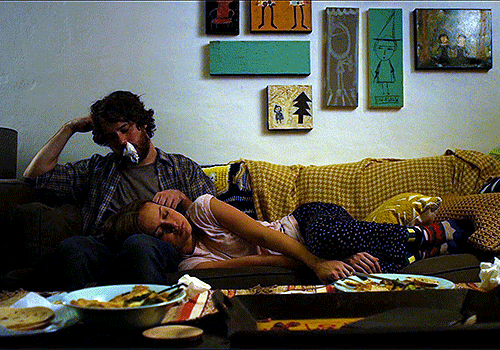
Short Term 12 (2013) dir. Destin Daniel Cretton
#short term 12#filmedit#dailyflicks#cinemapix#romancegifs#cinemaedit#*#tenderblogging#one of the most tender relationships in cinema history it is so important to me#userraffa#userroza#usergabriella
76 notes
·
View notes
Text

Time loop: Twin sisters Joséphine and Gabrielle Sanz as mother and daughter in ‘Petite Maman’ © Alamode Film
Interview with Céline Sciamma:
“Alliances are extremely important”
An interview with French director Céline Sciamma about her new film ‘Petite Maman’ and the power of women.
By Susanne Lintl, kurier.at, 17.03.2022
[T]ranslated by @thexfridax
Whenever a French film succeeded in the past couple of years, it was very likely that she was involved in it: Céline Sciamma, born in 1978, does not only write excellent screenplays (among others for Jacques Audiard’s great suburban documentary[sic] ‘Les Olympiades’ or for André Téchinè’s ‘Quand on a 17 ans’); with her own films, she’s also become one of the most important voices in the European auteur cinema in the past 15 years. In her new film ‘Petite Maman – When we were children’ (coming to cinemas as of Friday), the follow-up to her multi-award winning female drama ‘Portrait of a Lady on Fire’, the staunch feminist and Lesbian (she was in a relationship with Adèle Haenel for a long time) goes on a tender journey of childhood. At the house of her recently deceased grandmother, an 8-year old girl meets her mother who happens to be of the same age, and finally begins to truly understand her through joint talks and activities.
“It was my idea that a child meets a young version of her mother. Children are a good topic in cinema, because they are precise observers. Vital analysts of their environment and of course of their parents. In a certain way, it makes you come alive, when you observe them. Children are curious and have their own perspective of the world. Instinctively, you think about your own life, your own experiences as a child,” says Sciamma in the interview with the KURIER[.] Of course, she’s borrowed from her own childhood: “There were many connections. First of all, I made the film in the city, where I came from, in Cergy-Pontoise. The house and the rooms are based on my grandmother’s house, which I remember very well. It’s made a lasting impression on me, because I felt comfortable at her place. Grandmothers are key figures for children, especially for girls. When they die, it’s a turning point, a terrible break.”

Céline Sciamma, renowned French screenwriter and director © APA/AFP/JOEL SAGET
Have you also built tree houses as a young girl? - “Yes, I loved doing that. We have also filmed in the woods, where I played as a child.”
In ‘Petite Maman’, Nelly and Marion grapple with reality while building tree houses or playing together, thus getting to know each other. The encounter with the past and her mother’s 8-year old self, makes the present clearer for Nelly. She understands why her mother often feels so sad. “She suddenly sees [T: cue KT Tunstall] her own history through a new lense,” according to Sciamma. A touching scene, where Nelly tries to dispel her mother’s fear before a major surgery, knowing full well that she will get through it: “Everything will be fine”.
Céline Sciamma likes films with and about young people, coming-of-age films that tell the stories of childhood, its loss during adolescence and how this leads to disorientation. ‘Water Lilies’ or ‘Tomboy’ are about this difficult search for identity. Her heroes are always women – they have shaped her, rarely disappointed her, and supported her during difficult times.

Building a tree house with your own child-mother: ‘Petite Maman’ © Alamode Film
“When I look back, then I see that alliances with women were extremely important for me. Alliances that I forged right at the beginning of my journey. With people, who are still present in my life. Especially with my producer Bénédicte Couvreur, who I knew since my film studies. You have to know who to rely on, otherwise you won’t make it.”
Sciamma is one of the initiators of Collectif 50/50, a feminist collective, which aims at promoting gender equality as well as sexual and gender diversity in cinema and audiovisual media. “A powerful alliance often doesn’t look very mighty, but it doesn’t matter. Stick together and believe in your generation, then we are strong. That’s what I want to tell women”.
Next, Sciamma would like to do “something international”. A film, which is not based in France. “I need to try something new. Experiment. Try out something different”. Sciamma hints at the direction this may go. She is an ardent admirer of the Japanese anime master Hayao Miyazaki, [of whom she says] in the US film magazine ‘Little White Lies’:
“I love his masterpieces like ‘My Neighbour Totoro’ or ‘Spirited Away’. It would be wonderful if I could make a film like that”. ‘Ma vie de Courgette’, for which I wrote the screenplay, was already an animated film”.
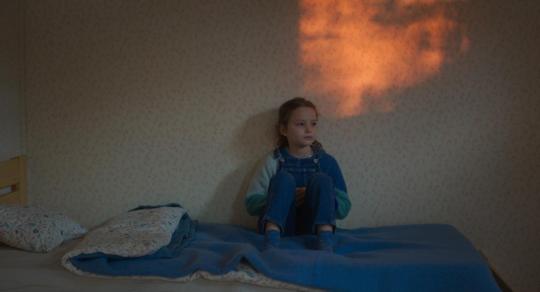
To better understand your own mother: ‘Petite Maman’ © Alamode Film
#Petite Maman#Céline Sciamma#kurier.at#March 2022 actually#Austrian#German interview#My translation#I forgot how to use language#Heh#The power of women#Looking forward to her next project
19 notes
·
View notes
Text
Three Films and a Couple of Thoughts
22.07.23 - 10.08.23
My phone calendar for July was not just marked with bill payments and birthdays but also the release dates of three films, complete with an accompanying reminder that would inevitably light the screen, catch my attention, ensure that I was booking the tickets in time. The films were ‘Past Lives’, ‘Barbie’ and ‘Oppenheimer’. I watched all three of them with my partner, my usual film companion if I’m not watching something with our parents or you, and each of these experiences – Past Lives, 6.05PM show at INOX, Oppenheimer, 11.55PM show at Cinepolis and Barbie, 12pm noon show at PVR – was singular in its own way, for a myriad of reasons.
Notwithstanding the absurdly high prices of tickets where a Rs. 350 ticket starts to look ‘cheap’ (to me, the upper-middle class consumer, with enough liquidity to throw cash even at a coca cola priced at Rs. 360!!), what was it like to watch each of these films in the cinema? Let’s also not forget that all three of these films are, to varying degrees, in English or English-centric (since Past Lives is a mix of Korean and English, subtitled only in English), the implication being that the audiences for all of these will be English-understanding, if not English speaking etc. I think it’s important to note all of these things – the cost, the language, the space of the cinema itself – in the present moment, before diving into the ‘criticism’ / ‘opinion’ portion of my piece. The subtext of all this is: how communal of an experience does the cinema still provide? Who can afford the obnoxiously priced snacks and the reclining seats, let alone the ticket itself? Who has the ‘time’ to luxuriously book a noon time show, in the middle of a work day, or one late at night in a city like Delhi? With the rapidly intensifying need to show more and more ‘content’, as made obvious by the number of screens in a particular cinema ‘complex’ (no longer hall, no longer single screen), the question that also comes to mind is this: is consumption everything?
When I watched the trailer for Past Lives, I felt an appreciative nervousness that seems to be evoked by nearly all A24 films; the subtle promise that this movie, this narrative will shift the way you might think or feel things. After all, a film about a Korean-American woman, married to a white guy, who then runs into her childhood sweetheart, is a film that can open so many doors, invite so many questions, evoke that complex sense of yearning and uncertainty, while attaching it to memory-making and the politics of identity. So I went into the hall with this promise in mind, expecting a complex and touching narrative about love, identity, history…but by the first half, it was beginning to seem that I had expected too much. In the interval, when my partner and I stepped out to get popcorn, we exchanged only sceptical glances and no words, both perhaps trying to let the film run its course, refusing an early judgement or indictment, generous to a fault.
Past Lives is one of the most disappointing films I have ever had to watch in the cinema. Not only did I nearly fall asleep twice in the first half, the gaping holes in plot and the sheer lack of any chemistry, or depth in any of the relationships made me want to pull my hair out. The film seemed to think that unnervingly long, awkward-without-purpose silences between characters is all that a context of tenderness requires – this particular choice irked me throughout. Our protagonist meets her childhood crush repeatedly over the course of 20-30 years, after gaps that are decades long and their conversation amounts to this: did you eat anything today? – UNNECESSARY FORCED SILENCE - What prize do you want to win for your writing now? – UNNECESSARY FORCED SILENCE - Do you and your partner fight? - UNNECESSARY FORCED SILENCE – and so on and so forth. If in these year long intervals, they have gained no curiosity about each other nor the ability to hold a single engaging conversation, then perhaps they should stop pretending they’re in love. The absurdity does not stop here, with the pretend-serious quiet that forces the film into disfigured drivel, but extends to all other aspects of the film – the protagonist has a younger sister and a pair of parents mentioned only once in the film, never to reappear or be mentioned onscreen again, the protagonist is a writer who stops talking to her crush the first time round because she wants to write but we never get to see what she’s writing, or what her work life is like or anything ‘writerly’ at all, the protagonist meets her white husband at a retreat and the ONLY conversation they have is where she monologues in the most dry, unaffected manner about ‘in-yeon’, a seemingly ‘deep’ concept that gives literally no weight to the film but seems to be its alleged driving force, before we drift into their marriage that has, again, no depth, feeling, tension, nothing, and in one particularly galling scene when the protagonist invites her childhood crush to a dinner/bar scene with her husband, the two of them start out talking in Korean with her translating into English for her husband before descending entirely into Korean, excluding the husband from the exchange which is mirrored literally by the camera cutting him out the frame. Not only is this absolutely, unfathomably unreal and stupid, they also manage to discuss what a ‘life together’ might have been like….right there, with the ousted white guy sitting somewhere within earshot. How has this not come up before, you know, when they met like 5-6 times alone? How can anybody take their spouse out with an erstwhile crush/flame and proceed to ignore said spouse for hours on end, without any ramifications? How is the said spouse not even hurt a tiny bit? What is the logic of this film? What is the meaning of this film? Is it enough only to put one ‘deep’ Korean concept in, fill the run time with awful, hankering silences and characters that appear to be more cardboard than real people, and put some stringy-ambient music in the background – in order to make an ‘art’ film, a ‘stunning’ cinematic debut?
I call bullshit.
At the end of the film, my partner and I turned to each other and both of us said….WHAT? IS THAT IT? IS THAT WHAT WE PAID SO MUCH MONEY FOR, AND GAVE OUR TIME TO? It was in a senseless, almost slurring kind of disbelief that we walked back home, unable to articulate how awful the film really was, especially because it pretended so hard not to be anything but ‘touching’ and ‘simmering’ and ‘beautiful’? When we pulled out reviews of the film, the disbelief sky-rocketed to another level. Past Lives was a critically acclaimed film, by the measure of most, if not nearly all reviews. We kept shaking our heads, wondering if we’d watched another film, the wrong cut, or if we were just stupid. Was there something we didn’t understand? Were we the ones missing something, and not the film itself? After all, in varying publications and across platforms, it was being hailed as a ‘masterpiece’. And the only words we had for it were: bull-fucking-shit.
.
Oppenheimer was a midnight show, and we were running late, having had to look for parking and the cinema itself - of course we would arrive at the wrong shopping mall first. We missed the first five-seven minutes of the film, but got settled in quickly. A fair amount of time has elapsed since I watched the film so my thoughts aren't quite as dense or immediate - it was an interesting movie overall, with a number of elements that faltered and misspoke. Here's what I liked: the impeccable sound design, often a 'staple' of Nolan's films, the 'character' of Albert Einstein (perhaps acted too perfectly, in my opinion, a portrayal that teetered on the edge of whimsy but never became a caricature?), Cillian fucking Murphy making the most of a script that didn't fully grasp or even attempt to grasp the complexities of Oppenheimer's life or the bomb dropping itself, the popping up of random actors - though after a time, it became a bit tedious. Hello, Rami Malek, is that all you'll be saying?
It's also indicative that the cinema was predominantly 'male', full of tech bros and cishet men that had turned out en masse to rave about Nolan - I am late to the discourse surrounding his films and the women portrayed in them (awfully, poorly, tediously, repetitively awful etc etc) but of course that was one of my major issues with the film. Plenty of reviews about this. I remain unconvinced by a film that leaads up so heavily to a world-history changing bombing but refuses to show us even ONE visual of the devastation in Hiroshima and Nagasaki. It's not enough to show us this singular white man's 'guilt' (very sparsely, might I add) - for a film made in this day and age, it certainly doesn't seem to want to reckon with the sheer scale of violence this moment unleashed upon the world. To be preoccupied with 'Oppenheimer' is a lazier, easier choice and still the film meanders in the second half, a little too obsessed with the trial / American politics, rather than the absolutely real time ramifications of the bomb. The film seems almost forgiving, when it should perhaps adopt a more complex approach to Oppenheimer. Don't even start me on the women - that's a whole other shit show. Literally nothing works in that realm, not for even a second, is any woman onscreen remotely believable or real, or even realized as a person. So Nolan has bumbled a number of things in the film - in parts, the film felt likes three different films put together, the editing was quite poor and abrupt, the women utterly destroyed in favour of a boring trial and an all-too-easily-forgiven antagonist, without a moment taken to acknowledge the horror he brought upon the world through his world. Underwhelming and not well thought out, I'd say but I really enjoyed the way sound functioned throughout film. For those raving about the 'cinematography' or 'visuals' - friends, come on, it's alright, it's pretty standard. Some things do strike you but overall, it's just alright.
.
We were on time for Barbie. What a relief. After watching three films with missing beginnings (these two above, and even the new Spiderman film!), I was relieved to see WB ads playing out on the big screen. My partner was very sorry that neither of us were wearing pink - the cinema hall was flushed in said colour, mostly, and I liked how 'extra' it felt, almost exuberant? But at the same time, the company making Barbies now making films about barbies - do we get more meta in capitalism than this? Probably. But that subtext stayed with me.
On first thought, right at the first watch, I really enjoyed the film. I laughed a lot, and I laughed at how much my partner laughed because some of the humour really worked well. Funnily enough and like a small majority, Ken emerged as my favourite character over the course of the film. The production design and the music was very well done most of the time, and some of the writing was very crisp, very intelligent. There were some issues though - many of which emerged in my conversations with other viewers, as well as my partner, as we read through internet discourse, reviews, tweets, instagram hot takes and so on, rethinking many of our initial thoughts. Though Barbie remained very much a fun film, one that should certainly be watched in the cinema, there was a sense that this film was just fun.
A great bit of superficial fun, that did not try to gesture at deeper meanings, nor truly try to break gender binaries (because how could Barbies???? even as there is one radical moment where Barbie and Ken, in the real world, tell construction workers, that neither has genitals, a radicality immediately defeated by how binarised the worlds remain and perhaps the fact that Barbie goes to the gynaecologist, confirming the bio essentialist reality of her as a 'woman' idk). Even the Weird Barbie wasn't weird enough for me - wasn't unsettling enough, wasn't subversive enough, didn't possess any qualities that might offset the 'sweet' 'funness' of the Barbie universe. No character beyond Barbie or Ken were developed, especially the real world mother-daughter pair upon whom much action hinges, but who remain empty vessels, unrealized people with no interior lives or histories, nothing. That one monlogue that has garnered significant praise across the Barbie discourse was quite average, in my opinion - it did not force me to think deeper or did it connect with me very emotionally. In a landscape where we've broken gender right open and are actively trying to collapse boundaries, this film did little in that direction, but enforced these dualities instead. I don't think it even properly examined how patriarchy reduces men and harms them deeply too.
I came across a recent review that seemed to be arguing that Ken should have his own movie - because this movie is called 'Barbie' and it should be only about her!!! and I found this to be quite a reductive approach because if you're trying to examine patriarchy and gender roles (forget race or ethnicity guys, that's pushing it right now) - then we need as many narratives as possible in there, and it was very interesting to see a 'Ken'. I did not feel that he 'took over' filmic space meant for 'Barbie', or that his presence or storyline detracted from the larger narrative - in fact, often, he was the most entertaining, compelling aspect of the film. I love Margot Robbie and she's done an excellent job, but I think the film overpromises - as does much of the discourse/reviewing around it. It's a fun watch, surely and you'll be singing along and you'll love the visuals - kinda made me think of Katy Perry's California Gurls a bit (I could think of other references too but eh?) - but it's a surface level film. You kinda get what you see, and not much else. And that's alright, perhaps, because it is a film by a company that essentially makes these dolls that many of us spent our lives idealizing (and yes, breaking etc etc). So yeah, thanks Greta Gerwig but you did a lot better with your earlier films. Feminism doesn't really need Barbie at the moment, I think.
.
I'm all done here, in a bit of a rushed manner. I also semi-watched this film Unpregnant on the plane but I don't really have much to say except I'm glad I didn't finish because it didn't make me feel anything at all, really. Average, average, below average?
As for this coming month, let's see where the watching and viewing takes me. You know, we're currently watching Good Omens together. Made in Heaven just came out. I also finished Wellmania. Perhaps time for another post, in a little bit. I hope these anecdotes get a little more interesting as we go, and perhaps more critical/well informed.
~ U
#oppenheimer#barbie#past lives#a24#film writing#critical reviews#independent blogs#siblings#share your work#greta gerwig#cillian murphy#florence pugh was done dirty#emily blunt was wasted#decolonise your gaze nolan#movie reviews#cinema#i love cinema#i need to watch more films#barbie 2023#oppenheimer 2023#barbenheimer#margot robbie#ryan gosling#nicki minaj#i'm not a barbie
4 notes
·
View notes
Photo
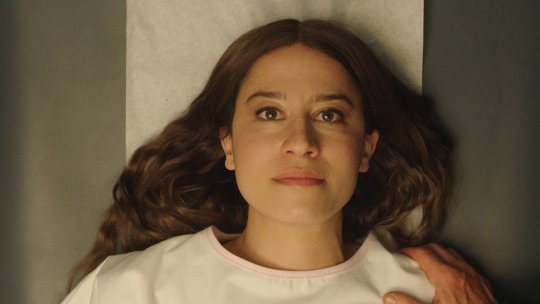
Beastly Baby.
False Positive writer and director John Lee tells Ella Kemp about causing chaos with his daughters, preferring to be in the kitchen at parties and using art to reckon with the darkest parts of life.
“Art is the history of destruction in many ways, so embrace that in your life.” —John Lee
Once upon a time, a woman called Lucy dreamed of having a little girl. She planned to name her Wendy. Struggling to get pregnant with her husband John, they sought help from miracle fertility doctor Adrian Hindle and, like magic, soon enough they were expecting a daughter. This is how director John Lee’s False Positive kicks off, but an opening shot of a blood-soaked Ilana Glazer suggests this fairy tale is of the darker variety.
The script, co-written by Lee and Glazer, deals with the twisty dynamics between men and women at a moment in life where trust should be more important than anything. Both Broad City star Glazer and Wonder Showzen co-creator Lee are best known for their work in television comedy. In making the leap to psychological thriller, the experience, especially for Glazer fans, feels increasingly unsettling. But it is a short walk from tragedy to comedy, so the reverse is usually also true—as many comedy creators before them have proven.
False Positive is about gaslighting, legacy, appearances, fairy tales and all the insidious feelings that get wrapped up in relationships that we often mistake for pure, true love. It’s also something of a contemporary homage to Roman Polanski’s Rosemary’s Baby (more on that in a minute)—showcasing, here, female agency in a much more complex way.
“The tensions of sacrificing one’s body to grow another… allows for greater glimpses into the diminishment of women throughout pregnancy,” writes Claira Curtis, with Wes Lawson echoing this succinctly by calling False Positive “a horror movie that asks ‘What if your pregnancy was entirely dictated by men?’” It works because of just how awfully compelling these men are—our favorite clean-cut James Bond star Pierce Brosnan delivers a wickedly unsettling turn as Hindle, while Justin Theroux, as John, proves a good bone structure might just be the most untrustworthy thing a man can offer you.
But the film would be nothing without Glazer as Lucy. A million miles away from her effervescent, stoner comedy in Broad City, she’s showing a different side here: a vulnerable woman trying with all her might to keep control over her body, her job, her autonomy, her future.
John Lee spoke to us about Glazer’s intuition, the power of destruction and how Peter Pan is at the root of everything. This interview contains discussion of the film’s plot.

John (Justin Theroux) and Lucy (Ilana Glazer) during a visit to Dr. Hindle’s fertility clinic.
To what extent is Rosemary’s Baby the parent of False Positive?
John Lee: I’m certainly standing on the shoulders of Rosemary’s Baby. In the history of cinema, it’s probably the most famous birth movie there is. But I just would say: let’s not continue down the path of Rosemary's Baby, let’s go the opposite way. I think one of the problems with Rosemary’s Baby is that it doesn’t quite get in the head of Mia Farrow as Rosemary. It’s a very removed movie, it’s equally about the two men in her life. I wanted to make sure that we were in Lucy’s head. I wanted you to experience what it means to be gaslit. Women know what that’s like, men rarely know what that’s like. I apologize! But that’s the truth.
Most men don’t know what it means to be debased in that way. I wanted to use cinema, which is so psychological, to really express that, because there’s a lot of psychological thrillers that don’t actually get into psychology. They explain things, and I didn’t want to explain things because I think sometimes evil’s not necessarily explained, it’s a feeling, it’s an experience. It’s that buzzy intuition that women, people of color and queer people have.
I wanted to do that in a way that is different than Rosemary’s Baby, in a way that I think is more reflective of an experience that my wife and I had. Before having our first kid, we had infertility issues, and so I wanted to really dive into that. And so it’s only Rosemary’s Baby in that it’s about birth. The joke that Ilana and I had is that we were making Rosemary’s Baby without the rape.
Speaking of Ilana, I’d like to borrow a line from the movie to ask you what she taught you, as a writer and actor, about female intuition?
Ilana is a very fiercely independent woman—and so is my wife, partner and best friend, Alyson Levy, who I’ve also made stuff with. I grew up American so, you like sports, you play sports. And there would be parties and men would be in the living room watching football, and I would go in there, and it was just extremely boring. No one’s talking or saying anything. So I would go into the kitchen, and there’d be these women laughing, crying, making fun of each other. And I was just like, “Oh, this is the place! This is where sarcasm lives.”
I also have a sister who is a big influence in my life, and then seeing my wife who just doesn’t put up with any shit, I’m kind of intimidated by it, and I’m in awe. So in terms of our process on the movie, I think I’ve just been infused with that for a long time and brought that awareness.
When Ilana and I wrote the script, I would let her take the keyboard and write that stuff—because I can’t speak it. I know the feeling of it, but it’s not my voice. We would have discussions but it was all very mercurial and open and free and collaborative in a way that there was no pressure. Collaboration is about being vulnerable and truthful. It’s being an ego sometimes, but also knowing my place to let things be.
When it came to directing Ilana’s performance, was there anything that surprised you once your dynamic shifted as collaborators?
I think the experience for Ilana was tough, because I took away all the things that make her a magical person. Her crazy hair’s gone, her sense of being a wild spirit is gone, her humor gone—all her tools. It’s brutal. I started to admire as we went on just how hard it was for her, so I would just try to give her as many hugs as I could! I would just try to support her in being able to be closed off, and then building up to the climax of the movie when she literally starts throwing punches.
We shot that at the end on purpose, so she couldn’t actually experience that, so she had to be in this tension. In terms of specific surprises, when Hindle inseminates her for the first time, and she and him have basically a sexual experience, I was really surprised by her version of it. It was so quiet and delicate and hopeful.

Lucy’s outburst at the end makes for one of a very small handful of moments in the film which features a very intense, guttural scream. These moments are extremely well chosen—how did you go about deciding which specific beats to give that visceral power to?
My job as a writer is to create as much tension as possible. I don’t care about explanations in movies and I’m rarely surprised by a twist. What I really enjoy is the transition from one state to the next, a metamorphosis. And birth is a metamorphosis, pregnancy is that, so I was really into that experience of just really sitting in the quiet nervous tension, this nervous laughter in a moment when you can only laugh because you don’t know how else to respond.
I wanted to give a little bit of relief, because you have to go through a journey and she has to scream at some point. She has to throw punches, or the movie’s just dire and I’m not that dire of a person. I’m really also very optimistic and I wanted this movie to be. Even though it’s a bit aggressive, the screams were an exaltation of her independence. Screaming is good.
During the pandemic, I’ve told my daughters, “Let’s go be destructive a little bit.” You have to! So we get those bubble teas and shoot them at cars. I’m like, “Let’s go smash a bottle! No one’s gonna get hurt, we’re not causing damage.”
But you do have to let that out. You have to find a way, whether it be through creativity or music or art, or smashing a bottle, to express that. Art is the history of destruction in many ways, so embrace that in your life. Lucy embracing that was important. From screams to punches to blood, to smashing. Because the phrase “smash the patriarchy” exists—it requires a smash!
But there’s also a tenderness to False Positive. The only thing that stops it veering into the abyss and being destructive all the time is the reliance on fairy tales. It’s in the score and in the script, crucially through the relationship the film has with the story of Peter Pan.
Before my wife and I had our kids we had a miscarriage, and I was reading Peter Pan at the time. In the book, there are chapters where the parents are sitting in the kids’ rooms staring out the window, waiting for them to return. I was reading that and I was trying to understand loss and memory. How do you get over something like that and just have a kid again? What does that mean to the kid you were about to have?
That notion of the parents staring out the window became one of the darkest things I realized, because there’s only two options: those kids were either thrown out the window, or someone stole those children. It really made me rethink Peter Pan—like, all fairy tales are actually dark stories. And then I started to realize the evil that men do is rape in every possible way: financial, physical, all kinds of control. The evil that women do is killing their babies. So I was like, “Oh my god, okay, that’s a movie, right there.”
So this movie is about that loss of innocence at your own demise, and what that means to try to understand the women who have done that, and why they did it. They had such a lack of support, institutionally, structurally and healthcare-wise. And what we do in this country is we just say, “Oh, that’s mommy brain.” We don’t actually say, “Hey, let’s give these people support for whatever they’re going through.” So all that is both profoundly dark and profoundly humorous, in the same way that when you ride a roller coaster, you either scream or you crack up. I want this movie to feel like that experience.
So if Lucy is a vague proxy for Wendy, who is Peter? John or Adrian?
Peter Pan, the trickster, is the Beast that makes brief appearances throughout the movie—Lucy’s intuition.

Pierce Brosnan and John Lee on the set of ‘False Positive’.
Let’s move onto some quickfire Life in Film questions. Pierce Brosnan in Mamma Mia! or as James Bond?
Pierce Brosnan in Mrs. Doubtfire.
What’s your favorite unconventional fairy tale?
It’s ‘The Story of the Youth Who Went Forth To Learn What Fear Was’ by the Grimm Brothers. There are three brothers, and two of them go to find something scary, but one can’t be scared. They do all these elaborate plots to make them scared, and the only thing that scares him is they put fish down his pants, and that gives him the shivers. They put fish down his pants on his wedding night, so it’s very clearly about sexuality.
I also love all these Asian fairy tales, in which I don’t think monsters have to be evil. They are a reflection of how you treat them. So if you treat them well, they will be well back to you. And so that’s Lucy’s intuition—there’s a monster in the movie, but it’s telling her to wake up. I really enjoy that kind of thing, you see that in a lot of Miyazaki films and I’m like, why don't we embrace that here? Why are we stuck in black and white?
What is the one film that made you want to be a filmmaker?
Stranger than Paradise by Jim Jarmusch. My girlfriend in high school brought it home, and she’s like, “This looks weird. Let’s watch this.” And I realized I had seen some of it before but then was just like, “Oh my god, this is an option? You can do this.” I grew up in a really small town with half migrant workers and half hillbillies, Steinbeck country. And so I didn’t realize you could do something like that. I just thought: whatever that is, I want to go down that path.

Tinkerbell, Peter Pan and Wendy in ‘Peter Pan’ (1953).
And finally: what’s your favorite filmed version of Peter Pan?
The Disney animated version. I think the song at the end, ‘He Can Fly’, is beautiful and we used a lot of references from it in the movie. All the other versions are a little hokey to me.
Related content
The ‘Good for Her’ cinematic universe: a list by Claira
Dogfood’s list of horror films in which pregnancy, insemination and/or childbirth are a major plot point
Body Horror: $am’s list of ‘something is wrong with my body’ movies
Follow Ella on Letterboxd
‘False Positive’ is streaming now on Hulu.
#false positive#ilana glazer#john lee#horror#body horror#films about pregnancy#thriller#horror film#letterboxd#pierce brosnan#jim jarmusch#peter pan#disney#miyazaki#wonder showzen
3 notes
·
View notes
Text
Oscar Isaac and Robert De Niro in the same film! 🤯
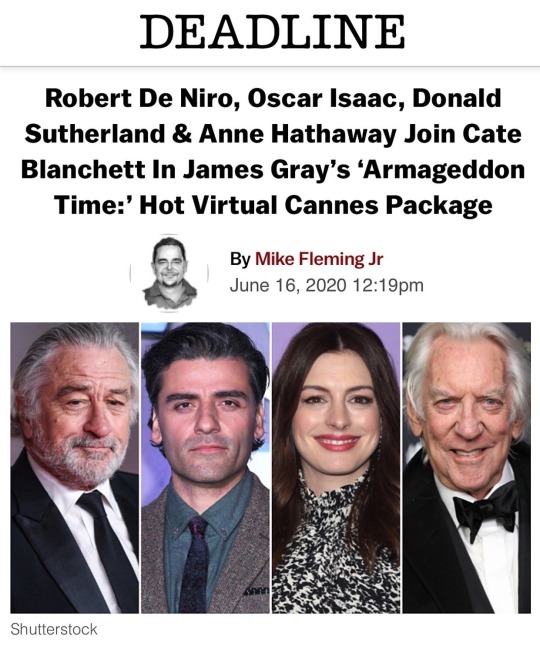
EXCLUSIVE: Robert De Niro, Oscar Isaac, Donald Sutherland, and Anne Hathaway are set to join previously announced Cate Blanchett in Armageddon Time, the period drama that James Gray will next direct for RT Features.
Wild Bunch International will introduce the film to buyers at the virtual Cannes market and represent the film’s international rights. CAA Media Finance, which arranged financing, represents the film’s domestic distribution rights. WBI and CAA Media Finance are co-representing the Chinese rights.
Gray wrote and will direct, and re-teams with RT Features following their recent collaboration on Ad Astra, the Brad Pitt space thriller that co-starred Sutherland. RT Features’ Rodrigo Teixeira will produce, with Lourenço Sant’Anna and Rodrigo Gutierrez executive producing.

Gray crafted a drama based on his childhood memories, a big-hearted coming-of-age story that explores friendship and loyalty against the backdrop of an America poised to elect Ronald Reagan as president. It is very different from his recent pictures, and he hopes to shoot in New York as soon as post-pandemic opportunities make it possible. He spoke to Deadline about his ambition.
“Every film you make is different, but I’m trying to do something that is the opposite of the vast, lonely and dark void of the movie I just directed,” Gray said. “I’m anxious to make something that is very much about people, about human emotions and interactions between people, and I want it to be filled with warmth and tenderness. In some sense, yes it’s about my childhood, but an illustration of familial love really on every level. I’m of the belief that most people do their best and that they try their best under difficult circumstances and in some sense that’s a beautiful thing and very moving to me.
“In a grander sense if I may sound a little sententious and pretentious, history and myth always begin in the microcosm of the personal and though you are using something so small and specific in your life, the result can become universal if it accesses real emotion. I’ve tried to move to the opposite of a cold dark space. I want to be political and historic about it, but fill it with love and warmth. What happened with me, very simply, I got in big trouble when I was around 11, though the boys are 12 in the movie, and the story is about my movement from the public education that I got into private school and a world of privilege. This film is about what that meant for me and how lucky I was, and how unlucky my friend was and about that break meant for me and what it meant for him.”
Previous stories mentioned that the private school was one attended by future U.S. President Donald Trump.
“The private school, yes Donald Trump went there and Fred Trump was on the board of trustees,” Gray said. “It’s symbolic about what the school represented at the time, entrenched in this white protestant ethic. I found it very foreign to me, a product of the public school system in New York City of the ‘70s. It’s about that transition and how it reflects on what the American society was and sadly still is. How we are separated along the lines of class and ethnicity. The film is really about that, my transition in school from one to the other. The implications of it are quite large. The world really became clearly divided to me, based on the haves and the have-nots. I didn’t write the script last week, but rather many months ago and it’s weird in that a lot of what we’re seeing right now is playing out of many of the themes that it was my ambition to explore in the first place. This obsession I have with examining American ideas of class mobility, to do it in a context that is humane with social impact.”
Gray is bullish that when moviegoing returns, people will want to be moved, and he believes Armageddon Time will fit that bill.
“Films do intimacy and family relationships very well, even better than the theater, because in the theater your best seat is still 20 feet away from the actor,” Gray said. “In the cinema, the close-up has tremendous power. What I’m after is something really quite moving. My recollection when I think back on that moment, which is 1980 as the time frame of the movie, and what an important year it was in the history of the country and for me personally and how in some ways, I was pretty damn lucky. My parents who were not wealthy at all as a working class family, used all the levers they could, to be able to go to this school. Which simultaneously saved my life, but also awakened me to real racism and anti Semitism. In some ways, the idea of presenting a story like this within the context of this family, told with great warmth, is sometimes your greatest Trojan Horse, to involve people emotionally that way. And story is a great weapon to be able to deliver some pretty harsh news.”
De Niro, Sutherland, Hathaway, Blanchett, Gray, and RT Features are represented by CAA. Hathaway is also represented by Management 360. Isaac is represented by WME and Inspire Entertainment.
###
#oscar isaac#armageddon time#james gray#robert de niro#donald sutherland#anne hathaway#cate blanchett#rt features
64 notes
·
View notes
Text
Bright Star : The visualisation of tenderness
This movie is one that I constantly revisit, the beauty and softness of it is something I want to carry with me. The soft colors, the delicateness of the moments that we see, and yet a story that moves hearts. This is the sort of stories I want to be able to tell and this is why I really wanted to write about this film.
I am just going to preface this article by saying that BRIGHT STAR (2009) directed by Jane Campion is one of my all time favorite movies and that I am going to be extremely biased in this article. Now, that this is out of the way, let’s move on to the article. Bright Star is a movie about the love story between John Keats and Fanny Brawne. But ultimately, it is a story about yearning, poetry and loss, at its core, it’s a story about love. Every shot of this movie encapsulates the tenderness and kindness which drives the story and Jane Campion’s directing. This movie is a highly romanticized version of John Keats’ life that centers Fanny and John’s romantic relationship and not necessarily on Keats’ career as a future legendary poet. The angle she chose to tell this story is a very soft and kind one, that is very empathetic toward both its main characters.

I’m going to start by placing the movie in its cultural context as well as in the cinematic industry that was prevailing in 2009 and still is today. Jane Campion is one of my favorite female directors and one I would qualify as an Auteur. Unfortunately, the cinema industry being as it is, I feel like so few women have the standing in the industry as artists that a lot of men have. Not to turn this into an interlude on the inherent inequality of the cinema world at large, but it’s easy to think of male directors that have a certain aesthetic and a recognizable way of making their movies. I’m thinking of Wes Anderson, Martin Scorsese, Quentin Tarantino, Guillermo Del Toro etc etc. For better or for worse, those cineasts are known for a certain style of works that is attributed to them . Female cineasts who get to be artists for more mainstream are very few in between, Jane Campion is one of them, but I could also name Anna Biller, Agnès Varda and Greta Gerwig. Women work at all scales of the industry and yet it feels their work is not valued enough for varied reasons. The industry doesn’t want to take A Risk (™) on a female cineast the way they do with male movie makers. The industry still has so much progress to do when it comes to centering stories made by people that aren’t straight cis white men, the films being produced for a mainstream audience are still majorly directed, produced and written by white men. You only have to see the recent award shows where the best directors nominees were all white men, despite women and people of color presenting amazing work constantly. Representation is important in what you see in the movies, non-white actors and stories featuring marginalized people, but what is also truly important as well, and I feel isn’t talked as much in the broader discourse about this subject, is how it’s important to have diversity behind the camera as well, whether it’s the director, writer, producer, crew, etc. I think we can safely say that progress was indeed made since 2009, but a female filmmaker being celebrated is still so rare to this day that i feel it’s important to remark on.
Jane Campion was still a celebrated filmmaker, despite having taken a hiatus from the film industry, and Bright Star (2009) did very well. The movie received many awards and nominations in such prestigious institutions such as Cannes or the British Independant Film Awards. Campion describes the film as more intimate than the previous ones she had made and in this regard, she is right. The way the film is shot and directed brings you closer to the characters and the story. The intimacy and the tenderness is almost overwhelming at times, she uses shots that are both very close and very near to give you a close sense of nearness and intimacy and to convey the emotions the characters are feeling, but also Campion uses a lot of very ethereal and shot. Hands brushing, butterflies flying around while one is lying on the grass, make this movie a literal visualization of soft romantic yearning.

One of the most important things to me in this movie, is how kind the narrative is toward Fanny Brawne. History hasn’t been kind to her, especially when we know that historians in general (ad im talking precisely white male cis straight historians who have been the ones to mainly write our History) have created the narrative that she was a despicable person, that she was a frivolous woman who didn't deserve to be in the vicinity of their favorite poet, simply on account of her being a woman who was more interested in clothes than rhymes and verses. and maybe she was, but on all accounts, John Keats was terribly in love with her, and she was equally in love with him. I just want to preface this by saying I would die for keats, I adoooore his poems and his writing and I have his complete works on my bedside table at this very moment.. I feel like its a very special kind of misogyny (or a very mundane one, now that I think about it) where the simple feminine presence of Fanny brawne near John Keats somehow tarnished him. The fact that she loved feminine things was a flaw that she needed to overcome for most male historians, they thought her futile and shallow, simply for the fact that she was a woman who was interested in clothes and delicate pretty things.
But more than that, she was also a skilled seamstress, she made her own clothing and was delightfully creative and hardworking, and the way Campion frames the craft of Fanny in the movie shows how valuable she thinks this skill is. Garment making is a really complex craft that requires skill and time and hardwork and to this day still isn’t valued the way it should be. So it should be no surprise that history, mostly written by male white cis historians, remembers Fanny Brawne as a vapid shallow woman who only cares about clothes. We can see that the character of Charles Brown, who will later be introduced as one close friend of Keats, is a bit of a placeholder for this sort of perspective. He constantly tries to thwart Keats and Brawne’s budding romantic relationship because he doesn’t think Keats should bother with such frivolous affairs. The movie is incredibly kind and tender in the way it showcases how craft, any craft, whether it be sewing or writing poetry, is work and a labour of love, and does not diminish the value of either to the advantage of the other.

John Keats is ofc a central part of this story. Ben Whishaw succeeds perfectly in bringing the tragic poet to life. Whishaw is perfect to play a poet who is about to die of consumption, he’s just very tragic that way. His delivery is perfect and he is the perfect casting for John Keats. (If you have the time, this reading of La belle dame sans mercI by Ben Whishaw is so delicate, beautiful and legit brings tears to my eyes ) I’m sure most of you know the story of Keats, but it’s still very tragic to think about : a poor and unsuccessful poet who died incredibly young and who never got to truly see how impactful his art would be in the future. Keats is still remembered today, but he never got the chance to enjoy the success his poetry had, years after his death. He never got to marry the woman he wanted to marry because he didn’t have the means to do it. He created beauty from his words and then died alone in Italy at just 25 years old. It never truly hit me before this year, when I did my annual rewatch of the movie, how young Keats truly was, being now 24 years old at the time of writing this article, it truly was a life that has been cut too short.

The directing of Jane Campion is very deliberate, and i think there’s a vision to this movie that is incredibly powerful and obvious. The movie’s pace is very slow, but I think sometimes we need media that just takes the time to slow down and to just enjoy the scene enfolding in front of us. I’m thinking about some scenes where you can only see Keats sitting on a chair outside. He is writing. The wind is moving through the leaves, the birds are singing in the distance, and Keats is writing. A lot of people would say that the scene is useless when it comes to moving the plot forward, and I guess i would agree, strictly speaking, that it doesn’t do much in terms of moving the plot forward, but it does set the atmosphere wonderfully. You can feel the calmness and the ethereal feeling of Keats’ poetry. Campion scatters moments like these throughout the movie, where she takes the time to slow down and get lost in the moment. It’s something that i particularly adore in media, as life constantly feels like it’s getting away from me, it reminds me to slow down and take the time to breathe.
The delicate colors of the cinematography are another aspect that I think really brings such a soft and tender dimension to the movie. The director of photography for this specific movie is Greig Fraser who also did the cinematography for such movies as Rogue One, Vice, as well Batman film starring Robert Pattinson but we aren’t talking about that atm. The colors that have been used throughout the film are very soft and soothing. Soft pinks and soft greens, as well as deep rich hues of blues and browns. There’s a haziness to this movie that very much feels like being thrown into a poem.
This wouldn't be an article written by me if there wasn't any mention of the costume design. The costume design in this movie is being taken care of by Janet Patterson, who had worked previously on other Campion’s movies (Portrait of a Lady, The Piano). The work she does here is marvelous. She manages to create such a beautiful wardrobe for each of the characters. From the colorful dresses of Fanny Brawne to the outfits of the last extra, everything is carefully thought of, and the attention to detail really stands out when you look at the clothing, from the historical research to how well the costumes fit within the realm of the BRIGHT STAR cinematic universe. John Keats’ outfits, in particular, were particularly delightful, he,s always clad in deep blues and clothes that seem worn and comfortable. Something about these darker blues just seem so melancholic compared to the rest of the costumes, especially in contrast with Fanny Brawne’s brighter dresses.

The last thing I will touch upon is the tenderness of the story in itself, despite how sadly it ends. The love story between John Keats and Fanny Brawne unfolds slowly, and then all at once. Despite all of what they go through, the love and the care they give each other is tremendous. And the times they have to be apart, you feel the yearning and longing for the other as if enveloping the scene. Having to wait for another letter, having to acknowledge that they can’t be together is heartbreaking, especially as Keats is desperately trying to do right by Fanny. They want to get married, but Keats is an unsuccessful poet who is in debt, and Fanny is from an upper middle class family and won’t be allowed to marry beneath her rank. I feel like it’s such a mundane story and yet, it feels world shattering to them, especially the last moments they share when Keats becomes ill and he has to leave for Italy to rest and try to get better, but they both know that it’s probably the last time they’ll see each other breaks me. The tenderness in each movement and each conversation they had was tinged by the heavy weight of saying goodbye one last time.
And then. The letter arrives. With the news of Keats’ death. And his fiancée cuts her hair, dons a black dress. And mourns him.

46 notes
·
View notes
Note
Hey, I’d just like to thanks you for staying positive though these Braime angst times because almost all the other blogs I follow went cRAZY about him “leaving Bri for Cers” and your posts gave me new hope and reminded me of all the wonderful things that happened in that episode, so, thank you so much💗💕💕💗💕
Glad to hear it, anon!
People have their feelings, they are entitled to them, but so am I and I am a very happy customer right now because I am a thirsty bitch for drama. And we are getting it! JB being at the very center *all of a sudden* (*coughs* biggest romance of GoT/ASoIaF *coughs* *coughs*) of the relationship conflict front tells us so much more than having to feel the angst. It tells us to feel the HYPE.
They are finally where we all wanted to see them… I guess ever since Harrenhal??? One of the producers called it something along the lines of “the most reluctant romance in TV history” in his commentary on the Red Tent Scene back in season 6. And I think JB is still living up to that and it’s beautiful and dramatic and I friggin’ love it. They *are* reluctant, have been for so many seasons (books, respectively). Because they are so caught up in self-doubt and for Jaime in particular self-loathing, feeling unworthy of a good kind of life, the kind of life they wanted to have or grew to want to have, feeling unworthy of love and affection and fearing that it could never truly be reciprocated.
I could start crying at the sad beauty of this right now, but my tears can suck it because I am way too much in the HYPE.
Because yes, anon! We were given so much goodness. Brienne smiled so much. Jaime smiled so much! Can you remember the last time he smiled like that?! I mean, we are all hyped to finally see Brienne smile, but think about how often Jaime only ever had a smile to spare only for shit to hit the fan all over. He didn’t have a time to ever truly have a breather and just be happy and fool around with his brother, and he got that, and Brienne got that, too. And they shared that happiness. It was so heart-warming that I felt like Jaime, wanting to nibble off my shirt lol.
Their first time (albeit a wee bit shorter than I as a shipper would have loved it to be, but you know, wishful thinking is one thing, and the rest can be filled with smutty fanfic :) of which our wonderful fandom provides plenty!) was awesome-sauce. The glow, the tenderness, the hesitance, the awkwardness, there was a purity to this encounter that it still has me shooketh.
And even the angst-filled goodbye… LOOK AT THE GUY! LOOK AT HIS FACE! LOOK AT HIS BEAUTIFUL, GORGEOUS, HANDSOME FUCKIN’ FACE! LOOK AT HOW HE BREAKS ON THE INSIDE SAYING THOSE THINGS JUST TO MAKE SURE SHE STAYS PUT!
BTW GIVE NIK ALL OF THE AWARDS! EVERY SINGLE ONE OF THEM! THAT GUY HAS A REPERTOIR OF EMOTIONS HE STUFFS INTO THREE SECOND BIGGER THAN THOSE OF SOME ACTORS HAVE IN THEIR ENTIRE CAREER! *waves fist in the air*
Sorry, had to get that off my chest. Back on topic:
Jaime has, ever since their roadtrip started, protected this woman. Nikolaj once commented about how Jaime sending Brienne out of King’s Landing back during the Oathkeeper episode was also fuelled by Jaime’s fear that Cersei may be on to something with Brienne after he saw her talk to Brienne and her walking off with a scared kind of expression (not knowing what truth bomb Cersei actually dropped on Brienne during the Purple Wedding aka that she loves him). The show changed the dress to an armor, a type of clothing literally meant to protect from bodily harm. He gave her Oathkeeper. And a squire to keep her company. Jaime has, at every step, tried to protect that woman to the best of his abilities within the constraints he found himself in. Do I believe that suddenly changed? Not for a fuckin’ second. This is Jaime Lannister as he lives and thrives. That guy is as hellbent on protecting the people he loves as Brienne is. Brienne is part of that circle, so of course he protects her, even if that means hurting her.
That is Jaime’s modus operandi alongside looking way too hot for me to handle. Or for him to handle, as last episode proved.
And just never forget him rubbing his thumb against her wrist. That shit still has me weak and whimpering at the beauty of it. That was just... poetic cinema!
The whole scene was a thing of beauty with the visual callbacks to Ned/Cat (arguably one of the few considerably healthy, longterm and strong relationships the entire series has ever seen, despite the fact that Ned was a douche sometimes - more often than not - and kept things from her that clearly made her feel shitty but that’s a topic for another day).
Brienne appearing in a robe that made her look lady-like and womanly and like a fuckin’ goddess rather than having thrown on breeches and a tunic or whatever! It made it all the more heartbreaking to have her feel that way while dressed that way because it just highlighted her vulnerability, but the VISUAL IS AMAZING AND THE NON-VERBAL CLUES THAT GIVES ARE OFF THE CHARTS!!!
Someone made that post and I am totally plagiarising this: this scene of her cupping his cheeks and him holding her wrist was a fuckin’ RENAISSANCE PAINTING. And JB is about to be REBORN. I am telling you!
Nik and Gwen acting the living shit out of themselves in that scene, giving us the rawest of emotions, acting out all with their facial expressions, with their FUCKIN’ EYES! Nik tells us all that we must know the way he looks at her!
So yeah, he ain’t a hateful man. He ain’t creepin’ back to his sister after having realized that Bri was not his jam. He’s doing what he’s always done, what he always does:
Protect, no matter the personal costs.
Not just Brienne, not just his family, it’s his finest act of slaying Aerys and thereby sending his reputation down the drain so half a million people could live that’s on the line! Those people are on the line! And Jaime is not part of that whole castle-swap game Daenerys and Tyrion are playing. If the guy has proven anything, then it is that he, despite of what he may have others believe or tries to make himself believe at times, is one of the few characters who actually give a damn on the smallfolk. He ended the Riverrun Siege without bloodshed (Jaime, seriously, revisit that scene, it’s in supercuts, you clearly got some things mixed up there, hon). He killed one man so half a million could live. It was not without purpose that Varys gave us that callback to how those people matter as much as any of them and how even someone Daenerys claimed to be so much more important because he is so clever, Tyrion, is in the end just as important as any other farmer going about his life. They deserve to live, and I think Jaime’s upset about Tyrion being like “just give him the Reach, what does it matter???” is all the more telling as it reaches beyond his personal conflict. The Reach is the center of food production and we are just giving it up to a sellsword who has no fuck-o to give about either politics or the people who live within the constraints of these? Fuck no.
Jaime wants to protect people. It’s been one of the driving forces in his character all along, even before we got to know him, when we were still led to the conclusion that he was just a douche that needed to be killed off because EVIL MAN!
Jaime wants to protect the people he loves in particular. For them, he goes extreme lengths. That was his family foremost, but that certainly included Brienne long before they got intimate. He’s cared about her for so very long. So I do not believe for a single second that he’d just... forget that, be able to put that aside. Jaime can’t.
And he doesn’t have to. He just has to see that. And Brienne will make him realize that.
Because as much as Jaime wants to protect everyone, factors are now changed. He just doesn’t see it yet.
Because this time, he is in for a surprise as there is someone who will protect him the same way he is committed to that person’s protection. And that will make the crucial difference, it already does. He never had that with his sister. She literally threatened to kill him, literally sent an assassin after him for having the *effrontery* not to act the way she would have liked, not falling in line when she as Queen demanded it. Jaime’s never had anyone step up for him the way Brienne did. Jaime never had anyone protect him that way.
She stood up for him during the trial when Tyrion failed.
She saved him and he saved her during the battle against the living dead.
She certainly had conversation with Sansa to ensure he was welcome at Winterfell.
She will stand up for her man and will protect him - from himself if she must.
“Nothing’s more hateful than failing to protect the one you love.” - she won’t let history repeat itself with the man who finally loves her back.
She will protect Jaime.
Jaime will protect Brienne.
And that is and has always been the very core of their relationship.
And that core is beautiful and pure and no angst gets between that.
Thanks for coming to yet another TED talk.
#jaime x brienne#jaime lannister#brienne of tarth#got spoilers#anon#thanks anon#wacky rambles#feel the HYPE#and feel the JB love!
70 notes
·
View notes
Text
Them There Songs Used In Movies Creating That There Perfect Moment
Music and film have had a symbiotic relationship for as long as celluloid carried sound. Often times lesser films are elevated simply by the use of the perfect song (Kenny Loggin’s “Meet Me Halfway” made the almost run of the mill OVER THE TOP memorable for more than Sylvester Stallone adjusting his hat backwards) or a somewhat forgotten tune is resurrected thanks to it’s inclusion in a hit film (think “Bohemian Rhapsody” in WAYNE’S WORLD). There are those songs that have been with us for what seems like forever, but the moment they appeared in a classic scene, their association with their moving picture counterpart shines a light on them in a completely different way then we’ve ever thought of them (”Stuck In The Middle With You” in RESERVOIR DOGS). This is the beauty of the pairing of cinema and sound.
There’s an old tale about when John Carpenter first screened his 1978 film HALLOWEEN for some executives. Without a score present one of the female audience members attending claimed it was the least scary film she ever witnessed. That same audience, complete with that same woman was shown the same exact film a short time later, this time with Carpenter’s now iconic score attached and that same woman was astounded by how frightening the film was. She was certain changes were made in the editing process, but the truth of the matter was it was only the music that was added. Proof that music can make or break a film.
Everyone now seems to know how important a film’s score can be. Try thinking of an INDIANA JONES film without whistling or humming John Williams’ “Raiders March” theme. Nearly impossible. The same holds true for pop music when used properly in a movie. Ever heard Peter Gabriel’s “In Your Eyes” on the radio and not immediately thought of John Cusack holding that boombox above his head? Bet you at least once thought of rockin’ the Ray Bans, white socks and a button down shirt and little else when you heard Bob Seger’s “Old Time Rock N Roll”. Those of us familiar with those scenes seem to forever associate those tunes with those images.
Whether a film or scene needs a boost of adrenaline (Kenny Loggin’s “Danger Zone” in TOP GUN), a rousing anthem (Survivor’s “Eye Of The Tiger” in ROCKY III), a somber dramatic gut punch (Celine Dion’s “My Heart Will Go On” from TITANIC) or a crowd pleasing showstopper (Bill Medley and Jennifer Warnes’ “The Time Of My Life” in DIRTY DANCING), music, pop music specifically in film is as important a piece to a movie’s success as the actors the director or the script itself are.
What are the greatest uses of pop music in film? Here’s my definitive top 10 list of the greatest songs to appear in a film and the scene they’ll forever be linked to. Note: I’ve excluded songs that were written specifically for a particular film, so although memorable and great, tunes like Kenny Loggin’s “Footloose” or Ray Parker Jr.’s “Ghostbusters” are not addressed.
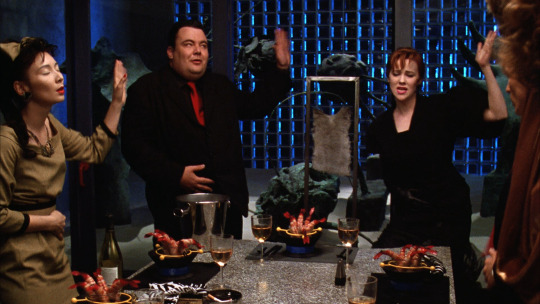
10 - Harry Belafonte - “Banana Boat Song (Day O)” - BEETLEJUICE (1988)
Director Tim Burton’s use of Belafonte’s “Banana Boat Song (Day O)” covers two attributes I spoke of earlier. It’s a song that is almost completely juxtaposed against the occurrences on screen as well as a nearly forgotten song that found new life once it appeared in the film.
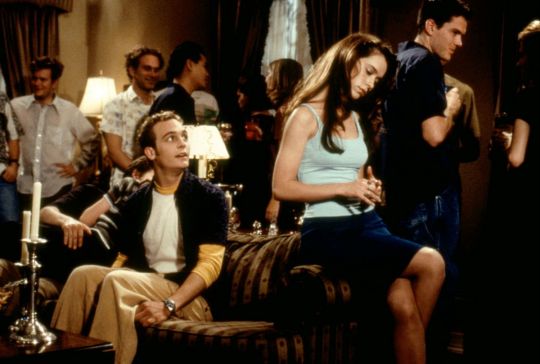
9 - Dire Straits - “Romeo And Juliet - CAN’T HARDLY WAIT (1998)
Right about the time gross out comedy was about to hit big with the likes of AMERICAN PIE (1999), a throwback to the teen angst filled rom-coms of the decade prior found itself a little audience. That film, CAN’T HARDLY WAIT had an onscreen couple you couldn’t help but root for in Ethan Embry and Jennifer Love Hewitt. Throughout the film, like many in a long line before it, our love struck protagonist Preston (Embry) tries to drum up the nerve and courage to ask his longtime highschool crush (Hewitt) out, in this case before their final graduation senior party comes to an end. One of the film’s more tender moments is when Preston, contemplating his next move before time runs out, does so while the Dire Straits ‘’Romeo And Juliet” sets the scene. It’s heartwarming and perfectly timed.
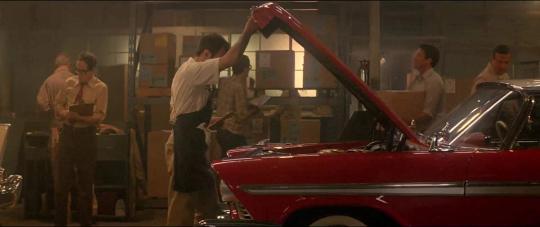
8 - George Thorogood And The Destroyers - “Bad To The Bone” - CHRISTINE (1983)
Used in films quite often, George Thorogood And The Destroyers’ “Bad To The Bone” is often played for laughs (TERMINATOR 2: JUDGEMENT DAY (1991)), but for my money it’s appearance in the opening scene of John Carpenter’s CHRISTINE is it’s best use. If ever a demonic, possessed inanimate object could ever speak of it’s evils and the perils to come, this would be the song that voices those warnings of the threats ahead.
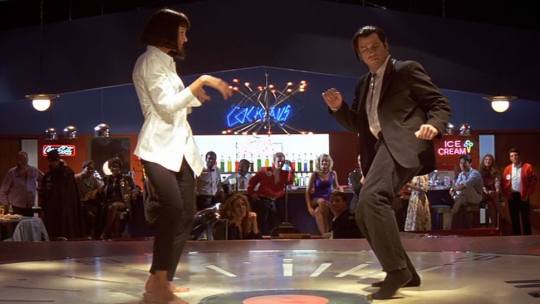
7 - Chuck Berry - “You Never Can Tell” - PULP FICTION (1994)
It’s a tricky endeavor to place an almost three minute dance scene in the middle of a hard nosed crime film. Do it wrong and you’ll almost certainly lose your audience. Do it right and you create one of the most iconic scenes in motion picture history. Quentin Tarantino’s gangster picture is full of memorable dialog and occurrences, but arguably none that encompass exactly the absurdity and attention to detail Tarantino has become known for like the Jack Rabbit Slims dance scene. For the film buffs you have John Travolta cutting a rug once again onscreen, long after his SATURDAY NIGHT FEVER (1977) days and better yet doing so to such an iconic Chuck Berry song. Classic.
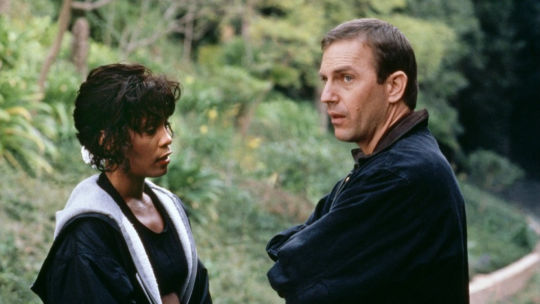
6 - Whitney Houston - “I Will Always Love You” - THE BODYGUARD (1992)
It’s a common misconception that Whitney Houston’s “I Will Always Love You” was written specifically for THE BODYGUARD. The truth of the matter is it was written by Dolly Parton way back in 1972, and released in 1974 as the second single from her album “Jolene”. It’s not even the first time the song appeared on film as Parton’s version was featured in 1974′s ALICE DOESN’T LIVE HERE ANYMORE, in 1982′s BEST LITTLE WHOREHOUSE IN TEXAS and in 1996′s IT’S MY PARTY. It’s the inclusion of the song in the 1992 Houston, Kevin Costner film that launched the song into cinematic history. Houston’s powerful vocals carry the tune farther than Parton herself was ever able to. Placed perfectly within the film itself, ��I Will Always Love You” sparked the right emotions the film was striving for and became one of the most popular singles of all time.

5 - Righteous Brothers - Unchained Melody” - GHOST (1990)
Who would have thought that one of the men responsible for films such as AIRPLANE! (1980) and THE NAKED GUN: FROM THE FILES OF POLICE SQUAD! (1988) would also give the world one of the most romantic films of the 1990′s? Jerry Zucker’s GHOST captured the hearts of nearly everyone when it hit theater screens in the summer of 1990. It’s “potter scene” featuring the Righteous Brothers’ “Unchained Melody” not only launched a litany of copycat humorous (some not so funny) spoofs, but it also catapulted the duo’s song to number 13 on the Billboard charts, almost three decades after it was first released and charted for the first time back in 1965.
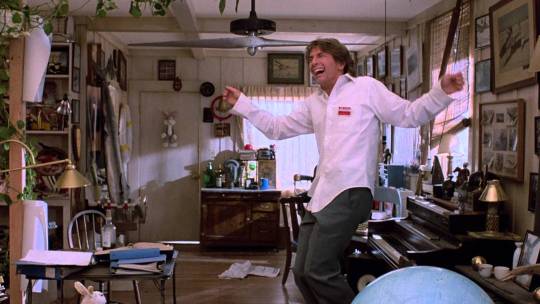
4 - Sam Cooke - “Twistin’ The Night Away” - INNERSPACE (1987)
***SPOILER*** There’s something sweet when two movie characters share “their song” in a film. Often times it’s done in such a manner that it purposefully tugs at the heartstrings. Joe Dante’s INNERSPACE takes a different route. With his lead protagonist Tuck Pendleton (Dennis Quaid) trapped inside unassuming store clerk Jack Putter’s (Martin Short) body, Pendleton, with the use of the music he often shares with his lost love interest (Meg Ryan) simultaneously loosens up the hypochondriac, nervous wreck Putter and wins back his girl, all thanks to Sam Cooke and a few remade tunes by Rod Stewart. The songs still play and offer realization to the characters, but it’s Dante’s approach that sets this film apart. The “Twistin’ The Night Away” dance scene is the cherry on top. Martin doing his best, vintage Martin to a fabulous Cooke tune. You can’t help but feel good after such a scene.
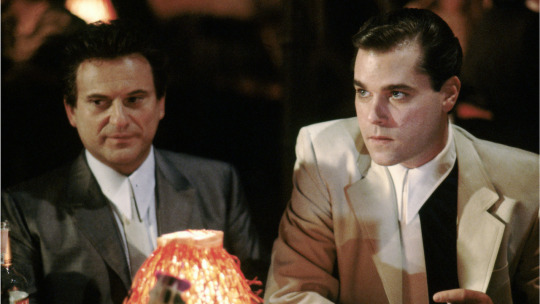
3 - Eric Clapton - “Layla” - GOODFELLAS (1990)
***SPOILER*** Now the meat and potatoes of this list. These final three embody everything I love about film. Talk about juxtaposition. Martin Scorsese’s usage of the outro from Eric Clapton’s “Layla” is the perfect example of this exercise in film and music marriage. As the deadly finale to the Lufthansa Heist rears it’s ugly head, the opening piano notes play over the camera rising above the hood of a parked pink Cadillac. Inside the bodies of two of the “expendable” participants in the heist. The montage then goes on to show the discovery of the other principal cast members who met the same fate. It’s a chilling scene that reminds the viewer that all the glitz and glam of the gangster life that came before usually ends in this manner. Chilling and perfectly orchestrated filmmaking.
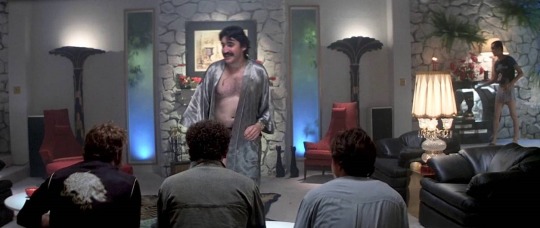
2 - Night Ranger - “Sister Christian” / Rick Springfield - “Jessie’s Girl” - BOOGIE NIGHTS (1997)
***SPOILER*** 1997′s BOOGIE NIGHTS already boasts one of the greatest scenes in cinematic history, the opening three minute tracking shot that rivals the one found in 1990′s GOODFELLAS, but it also features one of the most tense scenes ever to grace film stock. With life unraveling at lightning speed, Dirk Diggler (Mark Wahlberg), coerced by his rag tag crew, agrees to try and sell baking soda in place of cocaine to local eccentric and unsuspecting dealer Rahad Jackson (Alfred Molina). As the scene unfolds, the tension and anxiety build for not only the characters, but the audience as well as Jackson, high as a kite on his product, along side a firecracker throwing Asian boy toy, insists Diggler’s gang listens to his mix tape of assorted 80′s gems. Remember, this film takes place in the Regan era, so the character’s excitement over being able to experience and share his vision on a single audio cassette makes perfect sense. As Night Ranger’s “Sister Christian” builds to a crescendo, Diggler’s discomfort with the entire ordeal becomes evident. As the song gives way to the more subtle “Jessie’s Girl” by Rick Springfield, Dirk’s right hand man Todd (Thomas Jane) grows impatient and turns the once shady deal into a full on armed robbery. Needless to say things don’t end well for nearly all involved, with Diggler barely escaping with his life intact. It’s a masterful achievement in filmmaking and one of the greatest scenes in 1990′s cinema.

1 - Grateful Dead - “Ripple” - MASK (1985)
***SPOILER*** I’ve championed this film and it’s ending on multiple occasions. For me, it’s the most emotional scene in any film I’ve ever seen. As Rusty Dennis (Cher) starts her day, California sun in full effect, she becomes unnervingly aware that her physically handicapped son Rocky (Eric Stoltz) has not gotten up and made it off to school. She cautiously enters his bedroom, knowing exactly what she’ll face, but does so with a brashness and sense of denial that sort of makes the day seem as any other. Her son is dead. We know it. She knows it. As her denial gives way to sorrow, then to frustration we overhear The Grateful Dead’s “Ripple” softly playing on the radio. Rusty completely breaks down, smashing things with reckless abandon. The song still plays. As the scene concludes her anger and denial rests into a soft acceptance. The song still plays. She reapplies her son’s pins from his dream travel map that he removed the night before, knowing it was to be his last night on earth. The song still plays. It’s gut wrenching. If you’re human with even the slightest bit of compassion for your fellow man this scene will wreck you.

HONORABLE MENTION - Stealers Wheel - “Stuck In The Middle With You” - RESERVOIR DOGS (1992)
***SPOILER*** Quentin Tarantino films could populate a list like this all on their own. Being as I went and chose his usage of Chuck Berry’s “You Never Can Tell” from 1994′s PULP FICTION for the list, I decided it would only be fair to go to the Tarantino well once. Leaving off his “Mr. Blonde torture scene” would make a list like this invalid, therefore I’ve included it as the honorable mention. No need to dig into the gruesome details of the scene, if you haven’t ever seen it for yourself you should. If you have, you know what I’m talking about. An upbeat song played over torture and murder. It doesn’t get more diverse in content than that!
11 notes
·
View notes
Text
How Relic Explores our Most Primal Fears
https://ift.tt/2TEqOs2
All the major releases of 2020 have been postponed or released via streaming and cinemas are holding on by their fingertips, it hasn’t exactly been a stellar year for film. But as is so often the cast, one genre is holding on strong – horror. One of the very best horror movies of the year is Relic, a highly emotional, deeply creepy story of a woman with dementia and the daughter and granddaughter who come to care for her in her dilapidated old home. It’s a haunted house story of sorts where at times it’s the house itself that is doing the haunting.
Japanese-Australian director Natalie Erika James says she was a total scaredy cat as a child but her experience of watching a horror movie on the big screen with friends – which she describes as “The closest that you can get to death without dying” – gave her a thrill that she’s carried into her debut feature. It’s an incredibly personal piece with terrific performances from its triptych of women – Robyn Nevin as Edna, Emily Mortimer as her daughter Kay and Bella Heathcote as her granddaughter Sam.
Relic played FrightFest and The London Film Festival to great acclaim and in any other year it would be one of those buzzy genre movies everyone is piling into cinemas to see (check out our Relic review)
Fortunately, while Relic was released to VOD in the States, in the UK the film is getting a theatrical release so others can share James’ experience of being terrified collectively (albeit wearing masks and socially distanced).
James sat down with Den of Geek (via Zoom) to talk about the beauty of horror, creating a labyrinth and creating an animatronic gran.
You described your experience with horror as “The closest that you can get to death without dying.” That seems to be a very fitting description of where Relic lies…
Right. You can probably tell, it came from a really personal place. My grandmother had Alzheimer’s and she suffered for quite a number of years. And I was intrigued by the changes in her relationship with my mother and the dynamics there shifting, I suppose, where the child has to become the parent to their parents. I started writing the film on a trip that I took to Japan to go see her. And it was quite notable to me because it was the first time she couldn’t remember who I was.
I had a lot of feelings of guilt about that. And at the same time I would spend my summers at her house and it used to always scare me as a kid. Those two things coalesced in my mind.
People with Alzheimer’s, there can be moments of absurdity and levity that come from their condition, but also there can be very scary moments as well. Maybe unsettling is more the word. If they’re talking to people who aren’t there or who have passed. Or they’re convinced there’s someone in the closet or whatever it is. It felt like an appropriate genre to talk about fear in general, fear of mortality, fear of losing yourself, losing a parent, all those things.
The relationship between Sam and her grandmother is very affectionate and very tender and so some of the almost most unsettling moments are when she loses that.
Sometimes it feels like the grandchild-grandparent relationship can be very uncomplicated in a way that child and parent relationship can’t. So it’s, in a way, particularly heartbreaking when someone who’s only ever looked at you with love starts to turn.
You mention the house – production design is super important in Relic. Can you talk a little bit about that location?
We had two house locations. One was the exterior and the decaying grounds and one was the interior, mostly the downstairs. And then we actually built the upstairs bedrooms. We had to rebuild some of the hallways out to link everything together.
And of course it’s a labyrinth. It was almost a modular set in that we could take out areas to feel like there were different parts of it. And in that receding hallway, it’s more narrow. It was certainly a lot of creative problem-solving. And my production designer, Steven James Evans did an awesome job of putting it all together.
Did you have any particular inspirations for the look of the place?
I guess there’s a bit of Asian horror in that, the decaying nature of it. We wanted to stay away from anything that felt too overtly horror-signaling or Gothic with dark walls or anything from The Conjuring Universe. Instead we wanted it to feel like it was taking something familiar and something with a real deep sense of history and turning that on its head. Slowly making that comfort or familiarity unfamiliar over the course of the film in the same way that Edna is someone that you connect with and you feel for and care about and then she starts to really become a questionable presence. I suppose, in a way, it was more the Poltergeist approach of using lighter colors, blushes. Again, a real sense of history, the sense that things had once been really lived in and comfortable but that they were falling into decline and you could feel the neglect of that.
The imagery of Edna crafting the candles is fascinating and it slightly foreshadows what happens at the end, where did that come from?
Hilariously, it was originally an element that was changed because Hereditary came out when we were writing it. Originally Edna was making dollhouse furniture which was inspired by a short I did where the father had Alzheimer’s and it was a proof of concept for Relic. And his chairs were warping over time. So we were planning to just transpose that in Relic but, after Hereditary came out, we were a bit like, “Hm, it’s probably a bit too similar.” So we looked for another craft and we just settled on German candle carving. Certainly the idea of peeling and of layers was one of the reasons why we chose it.
You mention Hereditary and your film has obviously been spoken about in the same terms as that and, of course, The Babadook. How do you feel about that?
I take it as a compliment because I think they’re both wonderful, amazing, talented filmmakers. And I like both of those films so I’m totally happy with that. I wouldn’t necessarily call them direct references. Certainly, it was amazing to have seen the success of The Babadook in particular. Particularly because when I was pitching Relic around, people were really receptive to female-driven horror, it was something that people were looking for. So, timing wise, it couldn’t have been better.
Read more
Movies
Best Modern Horror Movies
By Don Kaye
Movies
Saint Maud and the True Horror of Broken Minds and Bodies
By Rosie Fletcher
Your story features three generations of women but would you say it’s a particularly female story or do you think it’s just a coincidence just because you happen to be a female?
I think it’s universal because we all have to deal with death in some way. I think the dynamics between the three women are specific to women, and particularly in the sense that caregiving often falls on women. So, I think it is specific to women in that way.
For me, it did come about naturally because it was my mother’s mother who had Alzheimer’s and those are just the relationships that are interesting to me personally. But I think there’s some specificity in it. I mean, I really liked the idea of three women because there’s a nice unity to seeing your future reflected in your mother and by extension her mother as well. So there’s something in that, that I don’t think would be as potent if it was, say, a mother-mother-son combination.
That final image of the three women holding each other is very specific and was very moving.
The idea of someone giving you life and how that loops around to the end, maybe. Obviously, men have a role in that as well, but something about them birthing is very physical.
Can you tell us a bit about shooting the labyrinth scenes towards the end?
The labyrinth was incredibly tricky. Partly because we were 40% over budget on what we wanted to build so we had to literally slash under half of it. We had to make the set a bit modular so that we could take away areas and make it feel like a different part of the set. And so it was a bit of a logistical nightmare with having to change sets in between set ups, and that kind of thing. But in a lot of ways the space so mirrors the disorientation and, I guess, almost the idea that Sam and Kate are being drawn into Edna’s experience quite physically as well. For me, the labyrinth is particularly key because it was one of the first images of the film that I had.
Relating it back to my grandmother, there was an upstairs area to the house where there were a couple of rooms that were just full of stuff and old furniture and memories and whatever storage space. And there was something really sinister and kind of heartbreaking about these rooms full of memories that just kept going deeper into the house and that you could lose yourself in that space.
And at the same time I’d seen, I think, a YouTube video or a documentary about a man who had Alzheimer’s and was describing feeling lost within his own house and that he’d often go to the kitchen and forget how to get back to the bedroom. So that always really stuck with me.
That’s really tough
It’s hard to shoot scenes like that, which are very high intensity emotionally but also where you have to cover a lot of ground because it’s being cut faster as well, so there’s a lot of coverage that you need to pull it off. There’s things that need to be reset, like wall breakaways as well, that are quite finicky.
It was all pushed to the end of the shoot and it was a very gnarly week. But so fun! I really could never anticipate how much I would fall in love with stunts in particular during this. I’d already had a massive, keen interest in prosthetics and visual effects. I don’t know if it was just the team but there’s something so incredibly exciting about it, especially paired with such wonderful actors and their performances.
Can we talk a little bit about the cast? So how did those guys come on board? And what were you looking for in those three characters?
It was definitely more of a creative discussion, I would say, of what pairings would work as a family because obviously they’re moving pieces. I had the opportunity to meet all three of them in person, which is wonderful, to be able to get a sense of who they were and what they read from the script as well. So I think, from the get-go, it was very clear to me that they all connected with it in their own way and in their own experience of death, I guess.
For Edna’s role I really needed someone who had a lot of charisma and a lot of range and who could, at one point be someone charming who you really were rooting for and who could turn on you the next moment. Robyn is just a force. And she has that intensity that was required but also is the sharpest, funniest person. So I think that combination was particularly striking.
For Kay’s role, interestingly, the feedback we kept getting was that she was very hard and unemotional as a character. And I always felt she was the most sympathetic, that she was caught between everyone. For us, she is the protagonist if you needed to single it down to one person. Someone like Emily softens all those hard edges because she’s just the most gracious and amiable charming person. So I felt like she was a good fit and it really was an ‘aha’ moment when we settled on her and thought of her. I’d long been a fan of her work. She has the most incredible instincts.
And with Bella’s character… I’d also been following Bella’s work for a while so I always knew I wanted to work with her. I guess, in the past she’s often been cast, because she’s so stunning physically, as quite feminine, demure characters. Then you meet her and she’s the most down to earth, cool chick. I really wanted a forthrightness in Sam that I saw in Bella and just a real honesty there and a toughness to her.
Where did the character of Jamie come from?
Jamie I can’t claim. He was actually more of Christian’s character, I have to say. Christian had been working on, I think it was a web series and one of his characters was a teenager who had down syndrome. I think we really wanted to sense that Edna had some support around her until she had driven that away. And I suppose that her loneliness had exacerbated the situation. So that was where Jamie came in.
Sound design is very important in the film as well. And it’s like these waves of echo. How did it work?
I really wanted to take quite a non-orchestral approach for this film and go with something that felt more diegetic and built from the worlds of the film. My composer, Brian Reitzell, was perfect because he does wonderful work of making his own instruments and strange sounds and capturing a feeling rather than focusing on melody or anything like that. He worked really closely with our sound designer, Rob Mackenzie and they each recorded sounds, whether that was made up instruments or them banging around in the house or whatever it was. Quite early they did that and so they had a shared library that they could both pull from. And that was great because it meant that there was a cohesive language to the design and the score.
I felt like I was underwater at points…
Yeah. Yeah. The echoes. Yeah. I mean, the house has such a presence as well. I guess there’s a sense of it really breathing in a way. And so finding those kinds of sounds were really key, like the breathing at the beginning of the film which is a slowed down heartbeat. Those were motifs that we decided on quite early.
Can you tell us a little bit about the final sequence – the peeling of Edna’s skin and how that worked?
Edna’s transformation had about nine stages.Stage one would have been the bruise and stage nine was actually an animatronic puppet.
They sculpted the silicon puppet and the animatronics were rigged so that you can control the smallest muscles in the face. I had two of the animatronics guys sitting next to me at the monitor with these car remote controls. It had a breathing mechanism so you had the movement of the chest too. It was really wonderful. And they sculpted the face off of Robyn’s face as well. So there was supposed to be some familiarity there as well.
In terms of the peeling, it was very difficult to reset, I have to say! Very fiddly, finicky. But Emily was just amazing. I mean, I think there’s such an emotional truth to that scene. It really is about almost helping someone die in a way, or a funeral rite if you want to read it that way. Not dissimilar to washing a loved one’s body after they’ve passed, something very intimate and visceral and very confronting, but ultimately an act of love.
It’s a very emotional film. How did you guys find that on set?
I feel like I maybe had a real, almost reverence for the puppet because it was such a beautiful piece of puppetry, to be fair. And I think it’s very easy to access the real life emotions when it just rings true and so we never really talked about it. We never really talked about it as a horror film. It was more like, “What does this mean? How does this relate to my own love for my parents and my own relationship with death?”
A lot of it feels like you’re trauma bonding with your actors. You have to be very honest with them because they’re so generous with you. It has to go both ways, I think.
Relic is having a theatrical release in the UK, is that important to you?
cnx.cmd.push(function() { cnx({ playerId: "106e33c0-3911-473c-b599-b1426db57530", }).render("0270c398a82f44f49c23c16122516796"); });
I mean, we did have a bit of a drive-in theater run and some local theaters in the U.S. But in Australia, in particular, it’s been a straight to VOD or rather a streaming platform called Stan. And to be fair, that was incredible to have as well because everyone was stuck at home at the time so it was like more people saw it than they ever would have. But I think there’s something about a cinema that maybe it’s a romantic notion, but as a filmmaker you really want people to get together to see it. Particularly for a horror film, you just want people to watch it in the darkness of the cinema and with the right sound levels and all the rest of it. I think there’s such a joy in that, in going through that horrific roller-coaster with people and surviving. I think that’s the beauty of horror.
Relic is released in UK cinemas and digital HD on 30th October.
The post How Relic Explores our Most Primal Fears appeared first on Den of Geek.
from Den of Geek https://ift.tt/3kIfN4O
0 notes
Text
My Top 20 Films of 2017 - Part Two
Ok, so about ten minutes ago I finished watching my last 2017 film of the year. For my FULL list - all 127 films watched in order of preference - jump on over to my Letterboxd page: https://letterboxd.com/matt_bro/list/films-of-the-year-2017/
Alright, top 10:
10. Logan
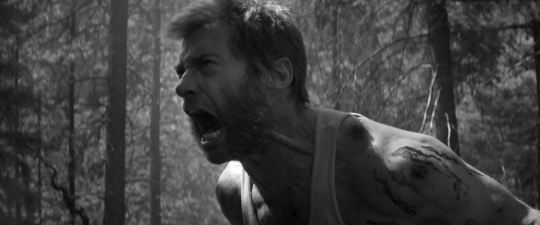
In a time when a lot of people still bemoan the existence of so many comic book movies (occasionally, with a point) this has been a stellar year for them. Marvel’s triple whammy of Guardians of the Galaxy Vol 2, Spiderman Homecoming and Thor Ragnarok were all excellent, heartfelt, fun knockouts and Wonder Woman was a terrific showcase for both Gal Gadot and Patty Jenkins (not to mention hugely important in its own right). Only Justice League really fell back on old tired habits and resulted in a bizarre mashup of tone and purpose and featured the single most damning piece of CGI buffoonery ever conceived in Henry Cavill’s ‘we’ll fix it in post’ deleted moustache. That really is one for the ages.
But I could never have foreseen the power and beauty of something like Logan, a near-perfect capper to a spinoff trilogy that began with the God-awful Wolverine Origins. It’s strengths come from it’s convictions – this isn’t an episodic story servicing a franchise, this is a true stand alone character piece, focusing on the rarest of things – an actual ending to a beloved, previously untouchable, immortal superhero. Played out as a tragic western with claws, the film beautifully champions the importance of family and love, seen (at last) through the eyes of those that never dreamed they would experience it, let alone fight for it. With some fantastic action set pieces to boot too, this one really has its cake and its eat and is also a real sight to behold – I saw it for a second time in it’s gorgeous black and white ‘Logan Noir’ cut and every frame is a revelation. Huge props to Patrick Stewart too, delivering a devastating performance of a character is has also lived with for the past SEVENTEEN years.
9. Film Stars Don’t Die in Liverpool

This film is a heartbreaker. My God. Definitely the most surprising cinema-going experience I had this year. I went with a friend of mine and by the time the credits were rolling, there wasn’t a dry eye in the house – best encapsulated by a burly scouser sat behind us who was openly saying “Fuck me, didn’t expect that for a Sunday afternoon. Jesus! How bloody brilliant was that!? Got any tissues?’.
Focusing on the later years of Hollywood starlet Gloria Grahame (Annette Bening on Oscar sweeping form), it finds her semi-washed up and treading the boards in London where she meets and falls for Peter Gallagher (Jamie Bell – never better than this) another actor, half her age. The tenderness and straight forwardness of their pairing is so refreshing, never making an issue or point about the older woman/younger man dynamic unless directly challenged by other characters (including Gloria’s bratty sister Joy) or themselves. The most effective emotional beats of this film aren’t signposted and drawn out for Oscar clip schmaltzyness but instead hit you in a sudden burst of passionate regret; hurtful words said in anger or defence – truly proving that the most harmful things you can say to someone you love are all too easy to let slip out before you’ve had a chance to think about what you’re saying. But the damage is done.
The film-making here is exceptional too. What could have been a rather dry biopic is given such momentum through brilliantly executed scene transitions and a flashback-enhanced narrative that keeps us embroiled in the present day scenes of Gloria succumbing to cancer whilst we watch their initial courtships and brutal arguments from the months and years leading up to it. The supporting cast that includes Julie Walters, back as Bell’s mother and Stephen Graham as his brother are brilliant but this is Bening/Bell’s movie and they knock it out of the park.
8. Baby Driver

My big birthday blowout screening of the year, following last year’s Aliens 30th anniversary showing, Baby Driver did not let me down. All the usual energy, narrative foreshadowing and tightly controlled construction you’ve come to expect from an Edgar Wright flick blown out onto a much bigger and more confident scale. The genius pairing of getaway driver crime heist flick and vehicular musical allows for some hugely inventive set pieces, from the opening police chase set to Bellbottoms by the John Spencer Blues Explosion to the car-on-car parking lot duel with Queen’s Brighton Rock echoing through the tunnels.
Ansel Elgort delivers a breakout turn and everyone from Jon Hamm, Jamie Foxx and Kevin somebody-or-other are having a ball playing bad. The romance with waitress Lily James initially feels a little under cooked but it all plays into the escapist fairytale of the action and seeing them dance together in a laundromat whilst sharing headphones is one of this year’s purest joys.
7. Get Out
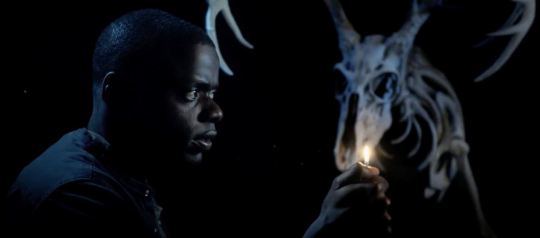
Where It soaked up much of the straight spooky horror acclaim this year, Get Out walked a much more tantalising and complex line between thriller, social drama, satire, comedy and horror – and pulled it all off effortlessly. Jordan Peele has long had grand cinematic aspirations as evidenced in some of the larger scale sketches in his fantastic show Key and Peele but this clearly represents everything he wanted to say and do in a debut feature. I think the odds of so perfectly nailing your voice and intentions in your very first film is astronomical but damn, he must be proud, not only of the film itself but the cultural reach, impact and resonance it has had with audiences.
Daniel Kaluuya is excellent as the everyman battling his own (rational) fears and paranoia before his instincts slowly become the domineering voice in the back of his head. Trust in oneself is the saving grace here and it’s great to see an array of other ‘traditional’ characters for this genre twist the knife and reveal their true colours. The “Rose, where are my keys” turning point is perhaps the tightest I’ve gripped the arm of my chair all year. And the eventual climax is one of the best examples of subverting expected genre tropes. Brilliant.
6. Raw

Speaking of confident debuts, Julia Ducournau’s is equally astounding. Not for the faint hearted, this queasy, cannibalistic coming of age tale is a near perfect slice of fucked up fever dream. It follows a young vegetarian attending veterinary college who is forced to eat rabbit meat in a sick hazing ritual – one that her fellow student and older sister has clearly already experienced. Slowly but surely, a triggering of her animalistic appetite grows, coinciding both with her own first steps into a sexual awakening as well as a growing sense of unease that something isn’t right in her family to begin with.
The plot takes some nutty turns, not least in the last few minutes, but everything works; from the gorgeous imagery to the tonal juggling to the assured performances. This would make an excellent entry in an ‘arthouse does horror subgenre’ triple bill, doing for cannibals what A Girl Walks Home Alone At Night does for vampires and The Witch does for... witches.
5. Jackie
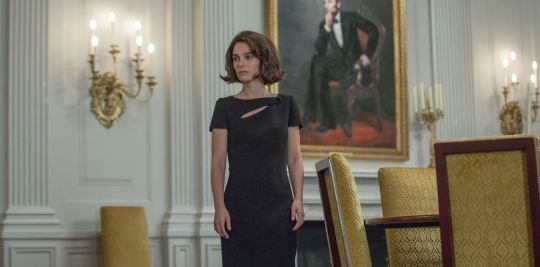
This is a breathtaking biopic - interested less in the broad strokes of history and what we think we know about the aftermath of one of the most infamous events of the 20th century and more in the nuanced, private, personal moments of grief in the public eye. Natalie Portman is astounding as Jackie Kennedy, nailing everything from the look to the voice to the affectations, and its the dreamlike, woozy way that the film unfolds that really draws you in and positions you in the eye of a hurricane. The JFK assassination was a monumental cultural milestone but this story asks you to put yourself in the shoes of a woman who was unavoidably trapped at ground zero - and largely all alone with her memories and emotions, despite the surrounding pressures of aides, the press and the American people.
This is supremely confident filmmaking, incredibly affecting and features another stand out score from Mica Under the Skin Levi.
4. 20th Century Women

The second film on my list for both Annette Bening and Greta Gerwig, this is a wonderful story about the strengths and flaws found in both the family we’re given and the family we choose. With an anecdotal, episodic structure, it is less focused on plot and more on the individual moments that the characters in our lives provide us with; how they affect our own life story and evoke memories of a certain time and place.
It’s highly emotional, with touching asides and rambling voiceovers telling us numerous stories whilst keeping a sense of an anchor through the relationship between Jamie (Lucas Jade Zumann) and his mother Dorothea (Bening). The supporting cast is uniformly great, from Elle Fanning as the girl next door to Billy Crudup as a lonely tenant/handyman, this one really hit me hard. The late 70s period details, along with the soundtrack, and the sun bleached cinematography recalls the joy of discovering yourself through questionable music, bad decisions and rebellious behaviour. Check it out.
3. A Ghost Story

I doubt any other film this year left quite a long lasting impression as this one did. I couldn’t stop thinking about it afterwards and became rather obsessed with pretty much everything it accomplishes. It’s a fairly straight forward tale of a couple (Casey Affleck and Rooney Mara) whose relationship begins to feel the strain as they quietly realise they might want different things in life. We’re not privy to many more details, positioned as a voyeur which will continue as things unfold but before long, Affleck is killed in a simple car accident outside his home and seemingly rises from death to haunt his old home, dressed entirely in the hospital bed sheet his corpse was covered in. It’s a genius depiction of the traditional ghost - simultaneously off-putting, amusing, whimsical and ridiculous - and it’s also rooted in logic too. As the ghost continues to watch his Mara grieve for him (mesmerisingly encapsulated in an unbroken take of a depressed Mara eating an entire pie that her neighbour brought round), he (and us) slowly begin to notice time... breaking.
The way the passing of time is visualised here is beautifully simple - rather than the long slow fades that normally indicate transitions, here it is as sudden as the ghost turning around to look over his shoulder, through a series of hard cuts or sometimes, no cuts at all. That feeling of time literally slipping away is brutal and the ghost can do nothing but wander about, seemingly helpless to how fast things change. One moment, Mara packs up and leaves, the next a new family of three have apparently been living there for months. Ultimately, the film becomes a meditation on the importance we embue in places, not so much people. The house is the anchor - the core - of what the ghost latches on to and if you’ve ever had the feeling of wondering who lived in your home before you and who will be there after you’ve gone, this film will dig deep into your mind.
I found this to be a brilliantly low-fi way to tell a huge thematic story and the use of music throughout - including one central track in particular - only adds to it. If you can get past the pie-eating without thinking ‘da hell is this’, you’re in for a treat.
2. Dunkirk
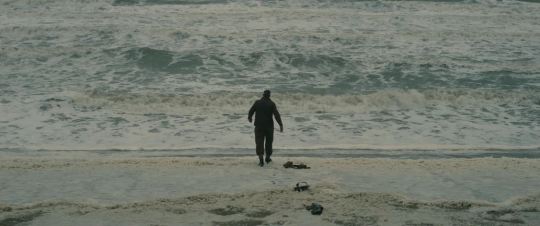
I’m almost scared to put this so high. I’ve no doubt in my mind that it’s a five star film and it’s certainly the most visceral, immediate cinema going experience I’ve perhaps ever had (I caught it at the BFI IMAX, opening night, at a late showing and it truly does fill your entire periphery vision) but a part of me wonders if it will hold up on second viewing - i.e. if seeing it anywhere other than the IMAX will diminish it. Well, I’m sure it won’t be the same but I’m also convinced it won’t matter either because this is clockwork precision film making of the highest order; an exercise in narrative structure as well as simply being the most accurate representation of the event in question as there possibly could be.
Some people have complained that this film does a disservice to its characters but I disagree. The power of this story is that it’s the tale of the everyman - how all of these people, no matter the extent of their involvement or the merits of their bravery, became heroes. I don’t need to see the ‘movie’ version of this - where characters chat about their backstories or show photos of loved ones or do every other cliche around. I KNOW all that is going on within the frame but I don’t need to see it. What we’re seeing is the immediacy of these events, which heightens the terror and the hopelessness felt by everyone on that beach or in those boats or in those planes. The land/sea/sky split is impeccably done and the devotion to practical battle scenes is stunning. The aerial dogfights - in full IMAX - practically made me feel like I was strapped to a wing. But even looking past the spectacle, the performances DO bring out the heart of the characters we’re presented with. From Cillian Murphy’s PTSD riddled soldier to the steely determination of Mark Rylance to the rather genius casting of Harry Styles - the exact kind of kid who would have been swept up in this war - everyone is all in and they all blew me away. Especially Tom Hardy, in perhaps his most restricted role yet (it’s like Bane meets Locke), who garners the biggest cheers.
And Hans Zimmer’s epic score can make me sweat just thinking about it. A perfect compliment to the tightening framework and increasing stakes of the action.
1. La La Land

Where do I even begin with this? Full spoilers ahead, I couldn’t help myself.
Clearly, this isn’t a film for everyone. And I get that. Some people think it’s fine but kinda hate musicals. Others get frustrated with the character’s choices. Others would have preferred it to actually remain a musical throughout. I understand all of these criticisms but for me, it does perfectly what it sets out to do.
First of all, I personally love the musical numbers - from the jaw dropping opening of Another Day of Sun to the kinetic, glamourous rush of Someone in the Crowd to the heartfelt yearning of City of Stars. I think they’re great tunes, wonderfully performed and exceptionally shot. I think of the long one-shot takes of the first, the swimming pool splashdown of the second and the little smack on the shoulder of the third. They’re rooted in feeling, in character and in the tradition of Hollywood. They wear their influences on their sleeve but never feel like a parody. And to me, the sudden shift away from being a flat out musical at the end of the first act is not a misstep but entirely organic - this is the rare love story that has its head in the clouds (romantic dating montages, dreamlike dancing through the stars) as well as being brutally honest about what we want, how we get them and the sacrifices these things cost.
The movie starts out as this fantastical anti-meet-cute before morphing into a romantic fable full of wonderment but the moment the characters get together, it switches gears and becomes more grounded in reality. The music largely stops and the real world catches up. Arguments are had, compromises are made, promises are broken. This is the harsh truth of getting what you want at the cost of losing what you’ve perhaps always wanted. The tension between Sebastian (Ryan Gosling) and Mia (Emma Stone) becomes uncomfortable - he’s lying to himself about doing what he must to achieve his real dream, even despite Mia’s support and she is battling her own demons in chasing hers. It’s only when the film brings them to their lowest points does it slowly turn back into being something more magical. Sebastian returns to Mia with the news of a new audition, which results in the most raw song/anecdote of the film ‘Audition (The Fools Who Dream), and just as we’re swept into the happy ending we were promised from decades of these movies, the pair realise they have to do their own thing. “We’ll just have to wait and see”...
The film’s extended epilogue is where it really doubles down on this idea. As we’re treated to a return of the ‘full blown musical’, we see the true Hollywood version of this entire story, played out in dreamlike fast forward. Sebastian leaping off his piano to kiss Mia the second he meets her, the villainous J.K. Simmons snapping his fingers and stepping aside, Sebastian giving a standing ovation at Mia’s one woman show that he missed entirely before, the two of them travelling to Paris and crafting a life together that Mia actually did alone. On the surface, it’s a joyous, colourful, happy finale but the final curtain reminds you that it’s all been... a daydream. The road not travelled. So while the film ends with them both achieving their own desires, they’ve lost one another. This is the all-too-often-true cost of creative pursuit and fulfilment and it’s so rare to see it held aloft in the final reel of an Oscar winning movie that appears to be the exact opposite on the surface.
It’s daring, brave and imaginative and it hit me like a ton of bricks. Maybe I’m too soppy and maybe I’ve just ruined the entire plot for you (I definitely have) but I just couldn’t see anything topping this the moment I saw it. And I guess I was right. Damien Chazelle is a wizard and I can’t wait to see what comes next.
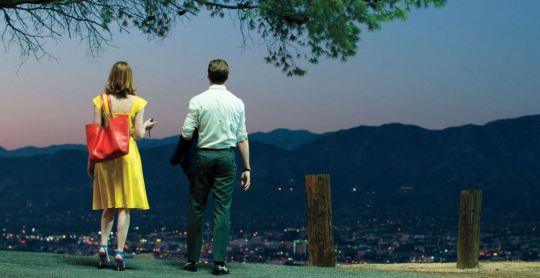
#top 10#Films of 2017#2017#logan#film stars don't die in liverpool#baby driver#get out#raw#jackie#20th century women#a ghost story#dunkirk#la la land
2 notes
·
View notes
Text
Day 6. ‘Dogtooth’ (2009), dir. Yorgos Lanthimos

On the relation of a part to the whole in film
***
Numerous writings in film theory, philosophy of film and art history tackle the difference between film and other artistic media, for instance, between film and photography, from which it allegedly evolved; film and theatre, with whom it allegedly competed, among other comparisons. If we imagine all differences and similarities between various historically established artistic media, they could hypothetically be organised into a complex Venn diagram in which theatre, music and film share temporality, or duration; photography, sculpture and painting share fixedness; photography and painting share two-dimensionality; film and photography share mechanical or digital material basis, film and literature share the editing element, that is, the juxtaposition of elements from temporally or spatially discontinuous events, and so on. I am in no interest or position to assess which of these differences or similarities are of definitive importance. That is, for example, I would not argue that the mechanicity that film and photography share is of more significance to their potentialities or their relation to reality than the temporality that film, theatre and music share.
The choice of one such characteristic, which has been fundamental to various theories of media, from Hugo Müstenberg and Sergei Eisenstein to André Bazin and Erwin Panofsky, appears to me to be arbitrary, merely a matter of personal prioritising. Thus, I am now focusing on the temporal aspect of film not to prove that film realises the potentialities of temporality better than theatre and music do, but because film’s duration (possibly, just like that of theatre and music) renders my mode of analysis of it different to that of, say, painting and therefore flags up something about the cinematic meaning.
Hypothetically, I perceive a painting in its entirety in a moment. That is not to say that it happens immediately, but that I can technically imagine an instant at which my reflections on various elements of a painting condense. Somewhat idealistically Michael Fried claims that “at every moment the work itself is wholly manifest”. I would say that it is not wholly manifest at every moment, but at least at some point at which the work is also wholly before me.
When it comes to film, I perceive one nucleus of image and sound per moment and attempt to determine their comprehensive meaning, yet I also need to constantly update my assessment in accordance to every new nucleus of that film appearing, be it a frame, or a scene, or a sequence, and develop my inner verdict only at the very end of the film. Thus, a film must be perceived in its totality at its very end. In a way, my opinion about a film is akin to a negative of a photograph that gradually develops in a dark room and then suddenly manifests itself wholly. (Once again, that does not render film either definitively different or superior to the other arts — a novel, too, must be read in its totality to be ‘understood’, and so is a play, but not a painting.) I am writing out these seemingly self-evident observations in order to discuss absurdist cinema, as what bothers me in it is how the absurd manifests itself both within the filmic nucleus and the filmic totality.
***
Guided by the irresolvable contradictions of current existence — do nothing in order to save lives — I decided to hold a week of absurdist cinema. It started yesterday with a classic — The Discreet Charm of the Bourgeoisie (1972), my reflection on which was violently interrupted by a bottle of Malbec — and is continued today with Yorgos Lanthimos’ Dogtooth. Dogtooth portrays a family in which three siblings live in a complete isolation from the outside world. Well into their 20s, they are treated as and manifest characteristics of small children, being continuously misinformed about the outside reality. Unaware of their ignorance, they are in what may seem like a trusting and even tender relationship with their parents, who provide basic necessities for them — food and at first outsourced sex. Intuitively, Dogtooth is located somewhere in between Lucile Hadzihalilovic’s Evolution (to avoid assumptions about influence, Evolution was released sever years after Dogtooth came out, in 2016) and Michael Haneke’s Funny Games (1997). With Evolution it shares the same themes of control and despotism via isolation and misinformation and an interest towards the bodily. With Funny Games, and I know that this is not an obvious or well-informed comparison, it shares a similarly cruel ridicule of the petty joys of the middle class with their rotten values, their nice living rooms, their invidious wine on the dinner table. Thus, the three siblings are told that the children are ready to leave the house when their dogtooth falls. They are also told that a zombie is a yellow flower. And that cats are dangerous beasts who feed on people.

Dogtooth is an example of Lanthimos’ exploration of the bodily and the linguistic — which is also manifest in The Lobster (2015) and The Killing of a Sacred Deer (2017) — and of their relation to making sense, with its characters barking on their fours and having mechanistic sex. Assigning the roles of children to young adults and making a claim that the mother, who seems to be well above child-bearing age, will bear two children and a dog, produces an effect of ostranenie, of making something strange and consequently revealing the constructed nature of any role-assigning procedures in the society. Pushing this logic further, it allows sexual experiment between the siblings, which doesn’t even appear unnatural due to the already-so-artificial-character of their social roles.
Dogtooth also tackles the ‘eye for an eye…’ (‘…dogtooth for a dogtooth’) logic, which is later expanded in and rendered central to The Killing of a Sacred Deer. Thus, characters exchange sexual favours for goods, such as a VHS with Hollywood films. These barters, too, make no sense, exposing the dodgy logic of justice.
I avoid writing directly on film, but prefer to write around it because I don’t think that any work of art can be exhaustively translated into words without loss. However, if I try to condense at least an element of Dogtooth in an intelligible thought, I would argue that the absurd here functions as both a means of control and a means of surviving control, but most importantly Dogtooth portrays absurd behaviours and situations in order to demonstrate that nonsense is the only reaction to control that makes sense. Coming full circle to the initial discussion of duration of film and of the need to assess it in its totality, it can be said that what is absurd in a shot, or a scene, or a sequence of Dogtooth makes perfect sense in the totality of the reality that it depicts.
0 notes
Text
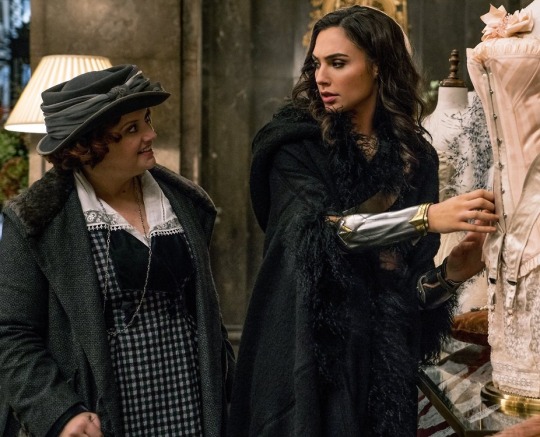
I did an otp question meme thing for Etta/Diana. Be warned: I’m basing this all off the movie, which I’ve only seen once. I might be iffy on characterization or speech patterns. Also, I rambled.
Who is the big spoon/little spoon?
Diana likes both, but Etta definitely prefers being the little spoon. The first time Diana tucked an arm around her in bed, Etta’s eyes got really wide and her breath caught, because while she’s a fierce, determined (and previously single) woman in her mid-40’s, she yearns for cuddles. Especially cuddles from tall, beautiful, badass women.
Favourite non-sexual activity?
After a number of truly disastrous dates, Etta finally loosens up about trying to corral Diana in public and just lets her be, and finds she enjoys going out and just exploring the city together. They do a lot of traveling, too, to wherever Diana is needed, and even though Etta makes a lot of frowny and/or exasperated and/or frantic faces over trying to be the more organized and responsible of the two during their adventures (you can’t just show up in another country and start winning people’s wars or solving crisis’s, Diana, there’s plenty else that’s got to be considered like food and lodging and not creating an international incident) she loves getting involved and making a difference.
Who uses all the hot water?
Diana, because it occasionally escapes her notice that she’s no longer in paradise, and she does have a very subtle spoiled streak (bloody princess); but Diana goes out of her way to make sure Etta gets to have relaxing baths and other self-indulgent activities, so it evens out in the end.
The most trivial thing they fight over?
Diana feels that Etta clings far to closely to social rules that make no sense (why shouldn’t I hold your hand in public? I was told this is to show others we are together) and Etta thinks Diana takes safety for granted. The issues are actually not trivial at all, but each thinks it is.
Who does most of the cleaning?
Etta. In fact she occasionally gives Diana a hard time about it, but when Diana offers to help, Etta waves her away. Dusting and ironing are as calming as making tea when you live a life of constant adventure. Yesterday Etta had to jump out of a plane. She’ll sort out the mud Diana tracked into the house, thank you. (Also, she did live alone for years, so doing chores on her own comes more naturally to her than trying to divide tasks with someone who’s never any of it before.)
What has a season pass on their DVR/who controls the Netflix queue?
As there’s no such thing in this time era, I’ll trade this out for seeing movies at the cinema. And usually it’s Etta, because she keeps up with such things and Diana doesn’t, though if Diana sees a poster she likes they’ll go to that one instead. Diana is much more spur of the moment, though, so when it comes to unplanned things – a walk in the park, a shared ice cream cone, sight seeing – Diana holds the reigns and Etta’s hurrying after her.
Who calls up the super/landlord when the heat’s not working?
Etta. She’s the first to get angry when something doesn’t work right, and she’ll get right on the phone or march right to the owner of an establishment (their apartment, a hotel, a restaurant, etc) and raise hell if she has to. She mostly prefers to shmooze her way through things, since it’s safer and gets better or faster results, but you bet your butt she’ll start it on you if that doesn’t work. If it’s something Etta thinks can’t be helped by talking (like how rude a man was to them or poor working conditions, etc), Diana starts giving dramatic, impassioned speeches, or starts yelling indignantly.
Who steals the blankets?
Both of them are guilty of it. Diana pursues everything with enthusiasm, and that includes being asleep and wanting to be comfortable; she’ll pull and accidentally roll Etta right off the bed if Etta doesn’t wake her up in time. Similarly, Etta sleeps like the dead and is still used to sleeping alone, so she’ll start curling up and tucking over and Diana will wake up naked and uncovered while Etta is a warm, comfortable bug next to her. It just gives Diana an excuse to smirk, turn over, and tickle Etta awake.
Who leaves their stuff around?
The less we talk about how often Etta trips over Diana’s weapons and Diana sits on Etta’s scattered newspapers, the better.
Who remembers to buy the milk?
One time Etta sent Diana out alone for an errand (she really didn’t want to, because of the many, immediately obvious reasons why, but she had her own hands full and Diana was so damned eager to help) and Diana came back six hours later with three new friends, having saved one from a minor factory fire, one from an abusive husband, and one’s cat from a tree. She did not remember being sent out on an errand. The cat was adorable, though.
Who remembers anniversaries?
Etta has an obsessive memory of precious dates but tries to be nonchalant about it, because who has time to fuss about over how many months ago a first kiss happened or when it was Diana first suggested they stop sleeping separately, but Diana always has a surprise for her or mentions it when whispering sweet things in her ear. Etta’s too charmed for her own good, but that’s being in love, she supposes.
Who cooks normally?
Etta loves to eat but isn’t the happiest about cooking – she gets anxious about making her own portions, because any time she’s showed an interest in anything culinary, someone has some snide comment about how tempting it’ll be to make ‘too much’. Diana loves her lover’s body and is quick to discourage fat shamers and Etta’s own internalized fatphobia, and one of the many ways she does this is by suggesting they cook together. She distracts Etta with being too bloody adorable, getting stuff on Etta’s face or trying to get her to lick her fingers, and it’s all smiles and enjoying flavors and no shame.
How often do they fight?
Etta will yell something in the heat of the moment (you can’t keep running off like that!) and Diana will raise her voice back (I am here to protect people!) but their actual arguments are usually had after the fighting or struggle is over and Etta wants to sit down and put her face in her hands and cry just to release the stress but won’t let herself, and Diana is still high on their success or, rarely, their failure. Diana is endlessly compassionate, so when she realizes Etta is only upset because she was frightened for Diana or frustrated at how fast and dangerous their life is, her face softens and she stops being defensive and indignant and instead comforts her, reassuring Etta that everything will be okay.
What do they do when they’re away from each other?
Etta worries, Diana pines, but both of them focus on whatever task is keeping them apart because it’s usually an important one.
Nicknames for each other?
As the months go by and their relationship progresses, Etta starts sassing Diana under her breath or behind her back, though it’s all out of fondness (bloody princess, absolutely out of your mind, etc) and occasionally when she’s feeling frisky she’ll call her “Di.”
Who is more likely to pay for dinner?
Etta handles finances and thus pays for most things, she often poses as a secretary at places they’re investigating for nefarious things so she’ll chucklingly help herself to a bit of cash on the way out if their concerns prove true. (This is in direct contrast to when she sometimes gets worried about stealing if Diana picks someone’s apple in a yard or something.)
What would they get each other for gifts?
Etta loves both frivolous gifts and practical ones, so Diana buys her things like shoes and umbrellas and flowers and treats, but most of all Etta likes candy, so of course that’s Diana’s first inclination when buying her something. Diana is always ruining her clothes so Etta tends to use gift giving as an opportunity to fix her wardrobe, but she’ll also sometimes give physical gifts, because Diana loves to come home and find Etta waiting for her in the tub or in bed.
Who kissed who first?
Diana started the kiss, drew back to make certain she wasn’t doing something Etta didn’t want to do, but it was Etta who dove back in with almost forceful need. Diana’s the most beautiful woman Etta’s ever seen, and Etta’s seen – and pined after – a lot of women.
Who made the first move?
Etta, I think, but only accidentally. She made some self-deprecating remark about being a bit greedy when they were talking about attraction (probably sitting on some balcony, watching couples walk by below), and when Diana asked what she meant, Etta talked about her lesbian friends giving her a hard time for falling head over heels for people regardless of gender. “It’s difficult enough getting by liking just the one, what with our lack of women-only islands out here in “man’s world”, however you’d like to call it. And here I am, liking men just the same, and whoever else I suppose, and that’s a bitter pill to swallow for some. They don’t notice that for all that flexibility, I’m still here alone.” And she laughed and tried to make it into a joke but Diana was looking at her with these big, full eyes, going from confused, to angry and indignant, to soft and tender. She held Etta’s hand and was like, “You are not alone” and Etta tittered and said “Well, the view’s certainly been nice lately” in this dismissive way, but Diana immediately smirked and murmured, “You enjoy watching me.” And it was not a question.
The rest’s history.
Who started the relationship?
Diana. She and Etta had been carrying on sexually for a few weeks, mostly a sporadic, in between missions/adventures sort of thing, when Diana asked for something more serious. She’d just saved Etta in a dramatic, action movie type situation, and while Etta was trying to be serious and NOT swoon, thank you, Diana smiled at her and said, “I would like to court you.” And Etta tried to wave her off with the usual nonsense excuses (I’m much to old for you) (I’m mortal, you remember, and you haven’t aged a day since we met) but Diana only smiled and told her, “You are a brave and beautiful woman. To share with me your heart” and she cupped Etta’s cheek, the goddamn cheat, “as you share your body now, would make me very happy.” And then she may have dipped Etta and kissed her in front of people, which resulted in a lot less thrown rocks than Etta was expecting.
Who cusses more?
Listen, Etta is a suffragette. She’s got plenty of dirty words to hurl back at shitty detractors.
What would they do if the other was hurt?
Defend them. Etta has scooped Diana’s weapon up more than once, sometimes just as a distraction and sometimes to kick some ass, and since she’s sometimes in the thick of it with Diana she often needs to be saved. It’s just part of the job.
129 notes
·
View notes
Text
Movie Minutiae: Notes on Top 10 Films
I revisit my top 5 and 10 films periodically, and sometimes I write notes like the following.
04 January 2019, 12:16PM PST
The top 5 didn’t shuffle too much from the last time I wrote some thoughts on film, with only a minor shuffle between “Paprika” and “The Tale of Princess Kaguya” from 3rd to 2nd and 2nd to 3rd, respectively.
“Mad Max: Fury Road” and “Inglourious Basterds” fell off the list because ultimately, I favored these movies for their editing as opposed to the overall effect. They both stand on my “Top 10 for Film Editing Inspiration” (maybe I’ll make a list later, if my psyche irks me enough) but they did not stand the test of time as films that really, truly reverberate with me.
There was definitely an interesting kerfuffle as to what would be in places 6-10 (these standings change the most at each assessment) and while “Minority Report,” “In the Kingdom of Dreams and Madness” and “Ratatouille” ultimately kept their places, there was ample room for ordering and re-ordering and re-re-ordering and re-re-re-ordering (and so forth...) ‘til there was some semblance of a (non)sensical list.
“The Host” and “Rashōmon” join the ranks as films that seem to resonate the most with me at this point in time.
The special mentions list – “Spider-Man: Into the Spider-verse”, “Black Panther”, and “Get Out” are unapologetically black films. It took awhile to parse down the special mentions list, and I found it interesting the all three films are centered around Black protagonists who, to a certain extent (some more than others) grapple with their own relationship to American racial politics and/or the post-19th to 20th century slavery and colonization African diaspora legacy. Special mentions are films that I considered very closely to be in top 10 but, for reasons I may not be able to articulate at the moment, did not quite but I still felt warranted a mention. This special mentions list is actually the most interesting I’ve had in a long while.
I am sad and disappointed that, out of my favorite films, only one is directed by a woman (Mami Sunada, who also directed my favorite documentary – maybe another list for “Favorite Documentaries” for another day is waiting).
I am also disappointed that most of these films are from 2002 and onwards, with only one film being from before with Akira Kurosawa’s “Rashōmon” from 1950.
Lastly, I am disappointed that my film preferences are still predominantly East Asian (Japanese, Hong Kong, Korean) and American (Hollywood and American Independent).
I hope with time, this will expand. (I am open to recommendations from anyone who is reading this.) As much as I love film, there’s still so much I don’t know much about, and ideally a year from today, my knowledge will have expanded beyond my current limitations that I’m disappointed with.
Notes on Top 10
#1: The Grandmaster [2013] - dir. Wong Kar-wai
Prior to the new year, I saw a number of posts about how 2018 was a terrible year that people were happy to throw away into a burning garbage dump — similar sentiments thrown at 2017.
Despite all of the current and ongoing tumultuousness, I still consider 2013 to be one of the most defining years of my life. It was easily one of my worst years, and easily one of the most important.
Heart break, economic instability, and workplace bullying consolidated into one giant slap in the face, resulting in me physically collapsing and being forced to take a few days off to recover. Additionally, two people I loved died unexpectedly: Roger Ebert, the man who cultivated my love in film and never once doubted me as a writer and filmmaker; and Bà Ngoại, my maternal grandmother who had survived two wars, experienced heart break of every kind, and always supported me throughout my adolescence and beyond.
All of this happened within 6 months.
“The Grandmaster” was the first movie I watched in theaters after my grandmother died. I accompanied Weinstein’s cut with a glass of whiskey, and cried for the first time after a week of feeling numb.
“The Grandmaster,” for whatever flaws it may hold, has continued to not only comfort me during the saddest and darkest of times, but has also helped me navigate times of uncertainty and instability.
It is flawed, grandiose, and arguably Kar-wai’s most commercial work.
I also learn continuously from it, flaws and strengths and all, and it has shaped my understanding and love of film, history, and how fiction can be more truthful than reality. Each character appears, disappears, re-emerges, and disappears again, imitating life as you may have it: the only constant is change.
Each character, with their own philosophy, stands out on their own, each a story waiting to unfold, and in some cases never revealed more than a whip of a blade.
Circumstances beyond each characters’ control shape them more than anything, and it is only through will, choice (some right, some wrong), and primarily luck that some characters persevere, and others return to the past.
While any character has the potential to be a grandmaster, only one emerges as a confluence of their will, the right choices, and unfounded luck.
C’est la vie.
That, among many other minutiae, is why it is highly unlikely that another movie will ever take its place as my #1.
#2: Paprika [2006] - dir. Satoshi Kon
How is it that Satoshi Kon was so prescient about society’s relationship with technology and personas, and by extension our projections of reality and fantasy?
“Paprika” is not a film that easily sits with one viewing. It is audiovisual fest, similar to a fantastical dream that one feels but has difficulty fully grasping without another viewing.
Fortunately, in the advent of records and media, subsequent viewings of “Paprika” are more than possible, and highly recommended.
“Paprika” is like a fervent, feverish dream, a dream that echoes truths about Japan’s sexism, codification of inferences/non-speak, toxic masculinity (figurative and literal), power dynamics, and projected versus actual love and personalities.
Kon has been one of my favorite animators of all time. I miss him still.
#3: The Tale of Princess Kaguya [2013] - dir. Isao Takahata
I was unsurprised to learn about Isao Takahata’s abusive tendencies and work environment upon his passing last year. Anyone familiar with brilliant minds and talent is also familiar with how that brilliance can be leveraged to excuse atrocious and abusive behavior.
Takahata’s rage against Japan very easily spread to those closest to him, and to what degree he justified this rage, perhaps I’ll never know.
What I do know is that in all of his anger, nothing shook me more than the anger he poured into creating “The Tale of Princess Kaguya,” a feat of Buddhism, beauty, joy, and a level of rage and despair that rises to challenge the level of rage and despair of his previous work, “Grave of the Fireflies.”
It is a tough question as to whether or not we can celebrate the work of an artist once it becomes that they were so abusive that their closest colleagues credit them for killing rising talent.
I think that, in a case against binaries, we can both celebrate and critique the work as it pertains to who its driving artist was.
In the case of Takahata, “The Tale of Princess Kaguya” is a perfect encapsulation of who he was: brilliant and brutal. Brutal, more so than brilliant.
#4: The Wind Rises [2013] - dir. Hayao Miyazaki
Did anyone truly believe Hayato Miyazaki would retire after “The Wind Rises?”
I certainly did, and that’s perhaps why I cried even more after finishing his fictional account of Jiro Horikoshi, the creator of the Japanese Zero during WWII.
I’ve been criticized for finding Miyazaki’s “The Wind Rises” moving given the fact that Horikoshi created an effective and efficient war machine — and, for those who know me, the critique weighs in on the hypocrisy given my stance on war and the military.
I understand the critique, and I understand the hypocrisy, if not the outright irony.
I’d like to believe that Miyazaki understands this critique, hypocrisy, and irony as well. (For those who wonder “how would you know Q?”, I invite you to Google his comments as to why he did not attend the 2002 Oscars to accept the Academy Award for Best Animation for “Spirited Away.”)
Was Horikoshi complicit in war? Was his seeming apolitical-ness a gross privilege? Was the Zero an engineering feat? Was this movie, in detailing the fascism of Imperial Japan, implicitly criticizing the current Abe regime’s continued attempt at historical revisionism?
I would like to argue yes, to all of the above. Because to be human is to be critiqued, hypocritical, and fundamentally ironic.
#5: Moonlight [2016] - dir. Barry Jenkins
How on earth are we ever deserving as someone like Barry Jenkins, especially in this day and age?
I ask myself that question every time I even think about Jenkins’ 2016 masterpiece, “Moonlight.”
I’ve only seen it once, and the moment I walked out of the theater, I knew it would be one of my top 5 favorite films.
As one of the quietest films I’ve ever seen, it is also one of the most powerful statements in cinema as it pertains to masculinity, blackness, queerness, and tenderness.
How does one linger on a gaze that says more than words can convey?
How does the omission of sound at a key moment elicit the key disconnect between trauma and bureaucracy?
How does touch transcend sexuality and into a need for love?
How does one reframe Miami as a landscape of poetry within the abandoned and discarded?
And how do you break boys into men without shattering their spirit, psyche, and very being?
These are all questions that “Moonlight” answers, and more.
#6: Minority Report [2002] - dir. Steven Spielberg
If you were already critical of me loving a movie like “The Wind Rises,” then I do hope you’re more than willing to give me hell for liking “Minority Report.”
Spielberg minimizes the more insidious nature of surveillance that is fundamentally flawed by opting out of actual critique acknowledging the power structures that underlie state enforcement. This cop out is further varnished by a slick Neo-noir cinematography that I have always admired, with specks of foreshadowing red indicating a “shit about to hit the fan” moments.
“Minority Report” is a classic Hollywood take on a Philip K. Dick novel that rudimentarily explores implications and then inexplicably ends without actually addressing the insidiousness of state-sponsored surveillance, incorrectly assuming that state surveillance will simply end on the basis of basic human decency, morality, and ethics (spoiler alert: it probably never will, because people are people).
Lastly, the film arguably glorifies the sleekness of said surveillance, what with its touch screens, looking glasses, automated cars that inspired a generation of iPhones, Oculi and Teslas. How does one dress up such a depressing notion, of a black mirror society in which we must gouge out our eyes in order to truly be free?
With all of this pessimistic analysis cultivated and grown for 17 years, I still hold “Minority Report” dearly in my heart because still, whenever I watch it, I find it worthwhile to watch while understanding how problematic the larger issues surrounding it are. It was, after all, the first movie that really got me thinking about what I was watching, and whether or not I should agree with everything said and implied.
This film taught me that things are not mutually exclusive: that you can explore ideas and still be enjoyable; that you watch something and understand how the implicit ideas are troubling; and that Tom Cruise will always be running.
#7: Ratatouille [2007] - dir. Brad Bird
I was an impressionable, nervous, and insecure 18-year-old about to embark into college when Bird’s “Ratatouille” came out.
I was especially unsure about what I wanted to do in life, as I had just had an existential crisis (yes, this is real) after realizing that, even if I became the best clinician possible, that the US healthcare system would force me to turn away patients who were too poor to afford health insurance.
So there I was, a lost 18-year-old, feeling like I had just thrown away 4 years of high school pre-med studying, and torn between continuing down healthcare or having a “oh fuck it all” and switching gears to film school.
Escaping into Pixar, I was engrossed in the Parisian adventures of Remy, an eccentric and misfit rat trying to break free of tradition by becoming a chef (an eccentricness and misfitedness that I heavily related to).
But what really did me in was Anton Ego’s speech at the end. To this day, I think he may have been a bit too hard on himself, but the sentiment still rings true 12 years later:
“In many ways, the work of a critic is easy. We risk very little yet enjoy a position over those who offer up their work and their selves to our judgment. We thrive on negative criticism, which is fun to write and to read. But the bitter truth we critics must face, is that in the grand scheme of things, the average piece of junk is probably more meaningful than our criticism designating it so. But there are times when a critic truly risks something, and that is in the discovery and defense of the new.”
“The world is often unkind to new talent, new creations, the new needs friends. Last night, I experienced something new, an extraordinary meal from a singularly unexpected source. To say that both the meal and its maker have challenged my preconceptions about fine cooking is a gross understatement. They have rocked me to my core. In the past, I have made no secret of my disdain for Chef Gusteau’s famous motto: Anyone can cook. But I realize, only now do I truly understand what he meant.”
“Not everyone can become a great artist, but a great artist can come from anywhere.”
#8: In the Kingdom of Dreams and Madness [2013] - dir. Mami Sunada
Mami Sunada accomplishes something quite striking in her documentary: she captures the existential pessimism of Hayao Miyazaki that, unless you read his interviews, would have easily eluded you. Because here’s the thing –
Miyazaki is a curmudgeon, a luddite, and a grump.
But most of all, he’s tired.
He’s tired of Abe, he’s tired of anime, he’s tired of consumerism, he’s tired of people trashing the environment, he’s tired of Japan, he’s tired of people, and he’s tired of life in general.
The only thing more tired than Miyazaki is, perhaps, a rotund white cat.
For all of Miyazaki’s curmudgeonry, Sunada manages to capture moments of sincere joy and tranquility, and more strikingly eases Miyazaki into admitting his own thoughts as unfiltered as possible by Japanese standards.
The ending scene, where Sunada holds the camera to capture the dichotomy between Miyazaki’s pessimism in contrast with the joy of pre-school children, is quite something.
#9: The Host [2006] - dir. Bong Joon-ho
Bong Joon-ho’s “The Host” is such an odd film.
I remember initial American reviewers were mixed, often citing that the movie was an inconsistent bag of emotions, and that traditional monsters don’t show the actual monster 10 minutes into the film.
They are correct on all counts, which is why this movie has stood the test of time for me.
What many American reviewers missed is that Joon-ho’s oddball monster movie is fundamentally about Korean-US international relations after the Korean War, especially with regards to American military presence within South Korea.
This evil exists because American scientists poured formaldehyde into the Han River, and through freak science, a monster is born. People are kidnapped and taken by this monster. Families are quarantined while they are grieving lost members. Old family drama inappropriately unfolds during times relegated for despair. The media and politicians lie.
Yet for awhile, the viewer wonders: is this monster truly evil? We have not seen it eat anyone. Perhaps it is not as horrific as it presents itself?
And that is part of the brilliance of Joon-ho’s film, because later he reaffirms that this monster is actually truly evil incarnate. It has already revealed itself to be evil – why was there any room for doubt?
But that is a fundamentally human mentality, because oftentimes evil is insidious and subtle, rarely revealing itself in broad daylight. Evil relishes in mystery before it kills, so it is understandable that we would find reason to doubt the monster actually kills people even though, in retrospect, the red flags were there.
I will reiterate that the media and politicians lie about the existence of the monster despite first person corroboration – a lie that they desperately work to maintain to the point of nearly performing a lobotomy on the protagonist who only wants to save his daughter from the monster.
The lie that the media and politicians stand by is a testament to society’s larger unwillingness to acknowledge evil when it flashes and smirks is grisly existence into our cornea, and the inherent farce and additional casualties caused when we are slow to respond and react for reasons the exclude morals, ethics, and humanity.
“The Host” is an odd monster movie because it exposes us to our own willingness to ignore evil until it unleashes more collateral than if we had simply admitted ourselves that something truly, unapologetically horrible had brazenly stuck its head in our doors.
Perhaps it’s something we can’t quite make eye contact with.
#10: Rashōmon [1950] - dir. Akira Kurosawa
A few weeks ago, a theology student pulled me aside and asked me what was the one question I wished I could ask my respective deity.
I told her:
“Why do people lie to themselves so they can sleep at night?”
“Rashōmon” addresses this same sentiment, and concludes on a profoundly depressing and stark note about the worser aspects of humanity.
For what are we but beings who will lie just enough to maintain our own narratives that may not align in the face of actual truth?
And if there is no narrator for actual truth, does truth matter?
Kurosawa rips apart the underlying aspects of Japanese society – and humanity at large – in which we will do whatever possible to preserve our own reputations, even if it means risking death, so long as we maintain our own dignity without admitting accountability.
Such is the farce of our own conditions sometimes, I suppose.
Special mentions
Spider-Man: Into the Spider-Verse [2018] - dir. Bob Persichetti, Peter Ramsey, and Rodney Rothman
What a beautiful, radical film. I honestly can’t believe that last year we were blessed with not one, but two beautifully unapologetically black superhero films that addressed different aspects of the Black/African diaspora as a result of 19th and 20th century colonization and slavery.
“Spider-verse” is what I consider an exemplarily radical film since it looks explicitly focuses on the modern demographic of Brooklyn while decentralizing (fridging) Peter Parker with the fundamental idea that anyone – yes, anyone, no matter what you look like, no matter your abilities are – can be heroic. It is as diverse as it is inclusive.
An extra shout out to the positive and supporting male role models. (I am convinced that Mahershala Ali should be in every film at this point.)
And goodness, what a radical breakthrough in animation. I’m sure Satoshi Kon would be proud of the climax. And what a soundtrack.
Black Panther [2018] - dir. Ryan Coogler
I watched this film nine times in theaters (yes, I am the person who helped run MoviePass into the ground and I don’t care) because it is a film that helped me get through some rough patches early last year primarily because of its female characters.
T’Challa is likeable, but Okoye is a whole different level for me: she has been a role model of sorts for me, in many different iterations. (Also, the rhino likes her more.)
And what a soundtrack to match such a cinematography.
Get Out [2017] - dir. Jordan Peele
Jordan Peele’s breakout horror still shakes me to this day, if not even more. It’s one of those films that, with time and age, only further sinks down into how horrific the circumstances that surround the non-white characters.
(Anyone that thinks that it qualifies as a comedy is, quite frankly, missing the fucking point. For fucks sake, this shit is horrific – why the hell would anyone laugh except for some kind of relief from tension?)
0 notes
Text
My top 50 favourite films of 2017
This is probably the year that I gave the most number of 10/10 movie rating. What a great year.
Of the 160 movies I watched this 2017 from 34 countries, here are the top 50 (including 2016 releases that I only watched this year) that made my cinema experience awesome.
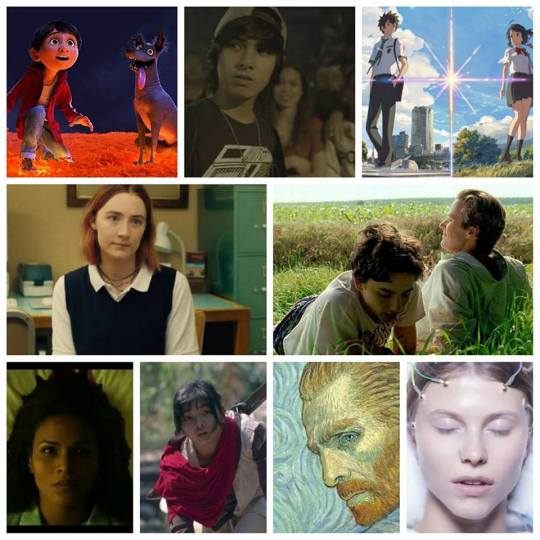
Yes, my list is kind of feminist, of course.
Kace’s Top 50
50. Tu Pug Imatuy [Arbi Barbarona, 2017, Philippines]

Great. Everything here feels authentic, it’s powerful. 7.5/10
49. Dunkirk [Christopher Nolan, 2017, United States]
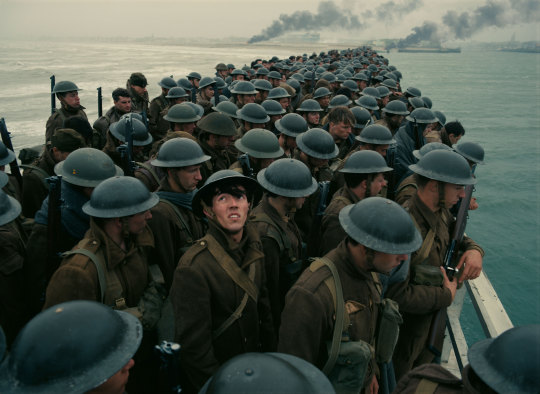
Boasts Nolan’s technical superiority. 7.5/10
48. I, Tonya [Craig Gillespie, 2017, United States]

Despite Robbie’s knockout portrayal, I still need to connect more with Tonya Harding. 7.5/10
47. Loving Vincent [Dorota Kobiela, Hugh Welchman, 2017, Poland-UK]

Focused too much on visual mastery, wasn’t impactful, narrative-wise. 7.5/10
46. Baby Driver [Edgar Wright, 2017, United States]
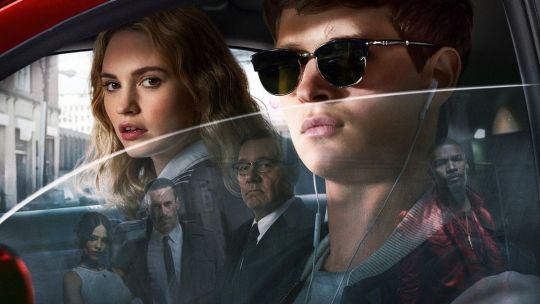
The ending blew it, but I had so much fun anyhow. 7.5/10
45. Everybody Loves Somebody [Catalina Aguilar Mastretta, 2017, Mexico]

Nothing much is special and new about it which is why I don’t understand why I love it to a great extent. 8/10
44. La Tortue Rogue [Michael Dudok De Wit, 2017, France, Japan]

A dialogue-less animation that proves that silence speaks a thousand words and could even provoke deep thinking. 8/10
43. Nocturnal Animals [Tom Ford, 2016, United States]

This is how a writer dies, and this is how a writer comes back with a kill. 8/10
42. L’Avenir (Things to Come) [Mia Hansen-Love, 2016, France]

At this point, everyone should know that there is nothing Isabelle Huppert cannot do. 8/10
41. Lipstick Under my Burkha [Alankrita Shrivastava, 2016, India]
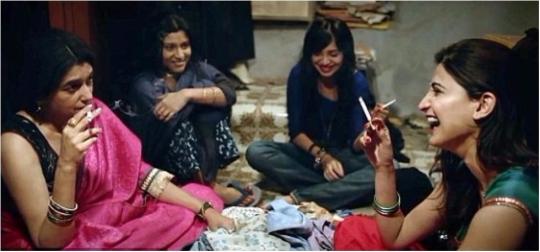
Comes with great intentions but lacks the powerful female characters the film supposed to have. 8/10
40. Ang Larawan [Loy Arcenas, 2017, Philippines]

Has such polished musicality that it overwhelms you to the point of it defying the flaws. 8/10
39. Blade Runner 2049 [Dennis Villanueve, 2017, United States]

Despite its cringe-worthy attack on my feminist self, it actually has a rich cinematic vision of a bewildered 2049. 8/10
38. Mother! [Darren Aronofsky, 2017, United States]

It wore me thin down to the core then ended quite brilliantly. My social anxiety is triggered, I am petrified and annoyed both at the same time. 8/10
37. D'Ardennen [Robin Pront, 2016, Belgium]

Just about the right amount of violence and grim unpredictability paced quite effectively. 8/10
36. Hidden Figures [Ted Melfi, 2017, United States]

For those questioning the existence of women figures in history, here’s a good start for you. 8/10
35. Hacksaw Ridge [Mel Gibson, 2016, United States]
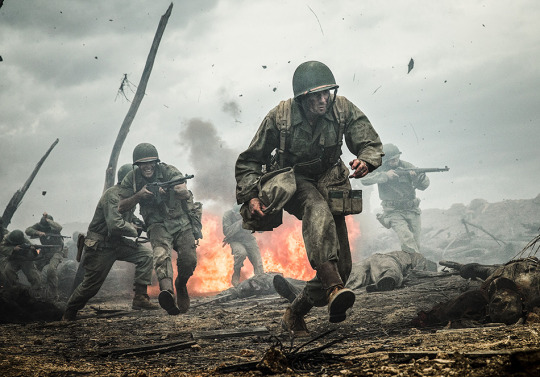
Is one of those war films that stand out. 8/10
34. Moglie e Morito [Simone Godano, 2017, Italy]
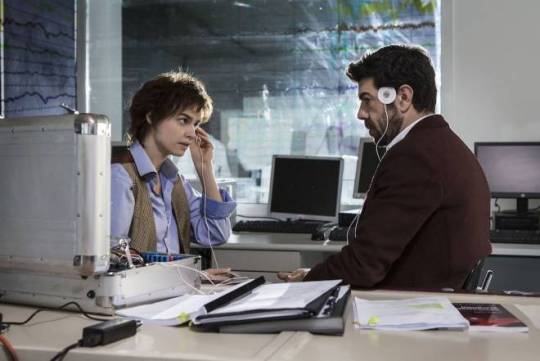
Could be the funniest film I have watched this year. 8/10
33. Personal Shopper [Olivier Assayas, 2017, France]

A subtle but dreary take on grief. Slow but rewarding in the end. 8/10
32. A Gift [Jira Maligool, 2017, Thailand]
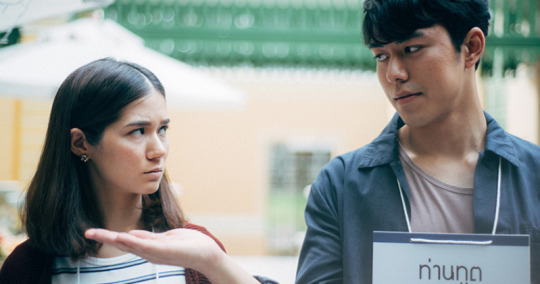
One of those films that could effortlessly make you laugh and cry. Charming. Very very charming – definitely a favourite. 8/10
31. Paki [Giancarlo Abrahan, 2017, Philippines]
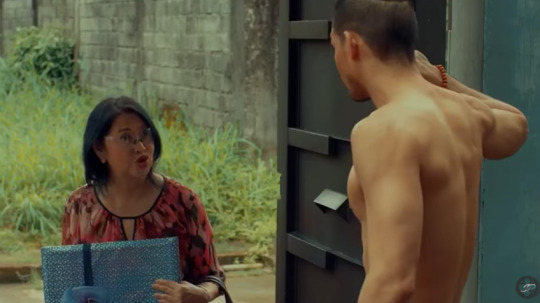
an illustration of how even the most prosaic narrative could be weighty through the power of storytelling and good direction. 8/10
30. Krigen [Tobias Lindholm, 2016, Denmark]

Feels a little rushed in the end, but affecting overall. 8/10
29. Beach Rats [Eliza Hittman, 2017, United States]
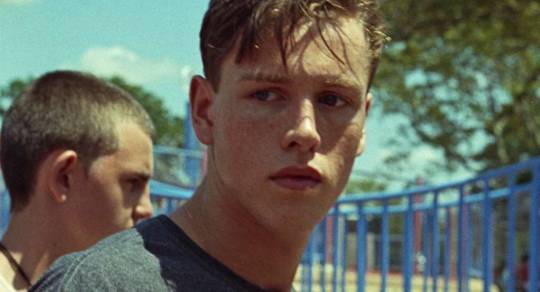
Overall, a substantial commentary on the stigma of homosexuality and its effect on why people choose to hide. 8/10
28. Chemi Bednieri Ojakhi (My Happy Family) [Nana Ekvtimishvili, Georgia, 2017]

Paints quite vividly a life of a woman in a patriarchal society. Remarkable. 8/10
27. Paterson [Jim Jarmusch, 2016, United States]
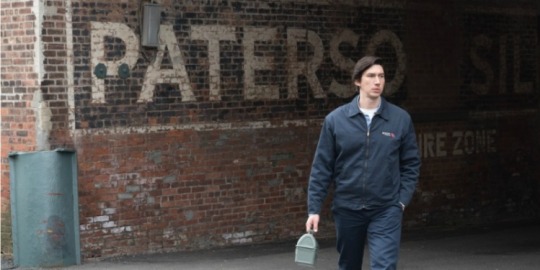
Poetic is an understatement. 8/10
26. Changing Partners [Dan Villegas, 2017, Philippines]

uses strong dialogues and character play that makes it rare and magical. 8/10
25. Coco [Lee Unkrich, 2017, United States]

Understands what La La Land doesn’t – relationships shouldn’t suffer when achieving our dreams. 8/10
24. If Cats Disappeared From the World [Akira Nagai, 2016, Japan]

a tearjerker drama that examines the essence of living as opposed to just merely existing. 8/10
23. The Killing of a Sacred Deer [Yorgos Lanthimos, 2017 Greece, UK , US]
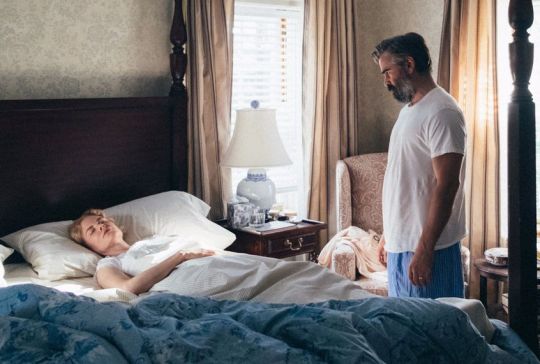
Yet another solid psychological thriller by the master of contemporary enigma. 8/10
22. Love You to the Stars and Back [Antoinette Jadaone, 2017, Philippines]

Kind of wants to make you believe in destiny, kind of succeeds in that sense. A tender take on teenage love and loss, so pure, it’s precious. 8/10
21. Battle of the Sexes [Jonathan Dayton, Valerie Faris, 2017, United States]

Makes me feel bad for not being alive yet when it happened. Ace. 8/10
20. El Acompanante (The Companion) [Pavel Giroud, 2016, Cuba]

Distinct character pairing in an equally distinctive tales of adversity. 8/10
19. One Week Friends [Masanori Murakami, 2017, Japan]

There’s a good reason for my sunken eyes right now, right? 9/10
18. Birdshot [Mikhail Red, 2017, Philippines]

Beautifully shot, it swims along two storylines at par – both in search for impunity in a corrupted society. Too relevant. 9.5/10
17. First Girl I Loved [Kerem Sanga, 2016, United States]

a tender coming-of-age drama that tackles discovering self-identity and the fear that comes with that realization. So raw, it’s thrilling. 9.5/10
16. Les Innocentes [Anne Fontaine, 2016, France]

a battle between religious order and moral conscience, one whose importance cannot be omitted. 9.5/10
15. Bad Genius [Nattawut Poonpiriya, 2017, Thailand]
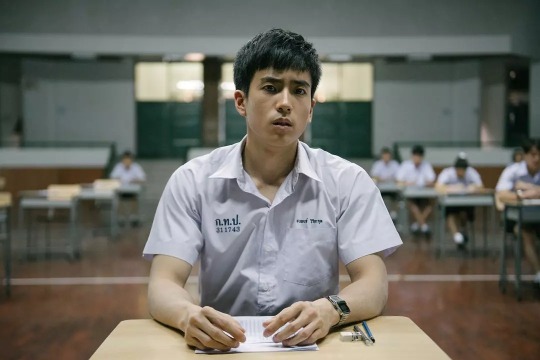
Brimming with excellent editing and direction, it is a thriller and an ingenius commentary on how social class inequalities lead to inevitable corruption. Brilliant. 9.5/10
14. La La Land [Damien Chazelle, 2016, United States]
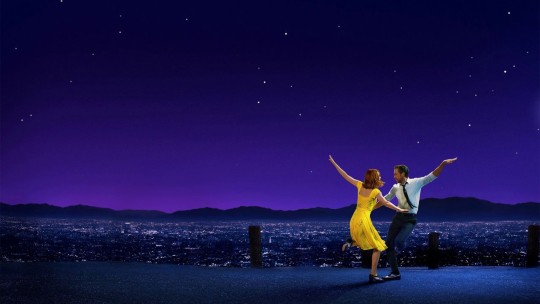
Is really technically excellent, but is also really disconnected. Kind of something you adore rather than love. 9.5/10
13. Manchester by the Sea [Kenneth Lonergan, 2016, United States]

a quiet yet profound drama narrated too effectively resulting to a mournful yet beautiful symphony. A film that brings the kind of sadness that is both painful and alluring. 9.5/10
12. On Body and Soul [Ildikó Enyedi, 2017, Hungary]

Too cold yet too heartfelt in all its complexity. 9.5/10
11. Thelma [Joaquim Trier, 2017, Norway]

Meticulously-crafted film that questions fundamentalism as a basis for joy and purity. I yearn for films as poetic as this. 9.5/10
10. Beats Per Minute (BPM) [Robin Campillo, 2017, France]

Goosebumps. This is a film clear of its objective, it is exhilarating and exhausting in the good kind of way. 10/10
9. Respeto [Treb Montreras II, 2017, Philippines]

Uses the power of words to compare past and present. Shows the cycle of oppression in a well-crafted film of bewitching artistry. 10/10
8. Three Billboards Outside Ebbing, Missouri [Martin McDonagh, 2017, United States]
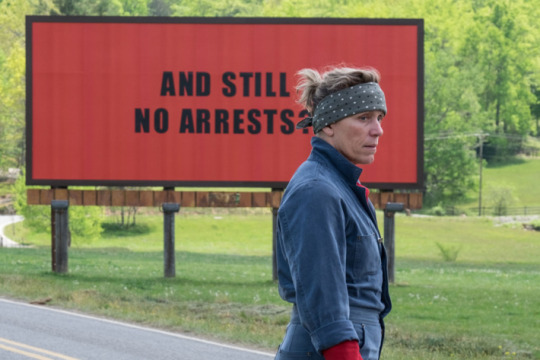
Too much hate and too much heart both at the same time. It is as shocking as it is enchanting. 10/10
7. Moonlight [Barry Jenkins, 2017, United States]
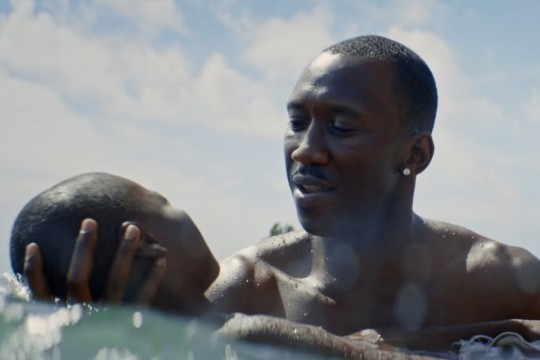
A rare impressionistic film on a man’s struggle to finding himself, something so rich in poetry and visual excellence, it’s spell-binding. 10/10
6. Salvage [Sherad Sanchez, 2017, Philippines]

A film that’s meant to look like a found footage, with one single camera perspective. It used unconventional, long continuous odd angles and silence that made it feel so raw and real, it’s haunting. 10/10
5. Arrival [Denis Villanueve, 2016, United States]
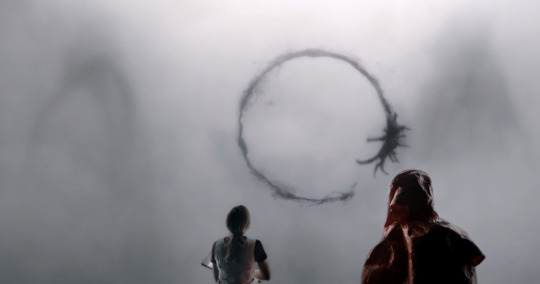
An admirable sci-fi thriller where aliens teach humans about humanity. 10/10
4. Your Name (Kimi No Na Wa) [Makoto Shinkai, 2016, Japan]

Star-crossed love at its smartest, warmest, and vividly-made anime. Something highly satisfying, I have no words. 10/10
3. Bliss [Jerrold Tarog, 2017, Philippines]
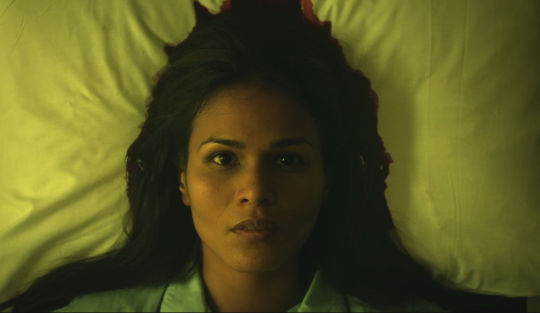
Touches the fine line between dreamland and reality, and examines dreams or aspirations as mere illusions. It is wicked. It’s well-crafted. It’s a mindfuck. It’s deeply, as in deeply affecting 10/10
2. Call Me By Your Name [Luca Guadagnino, 2017, Italy, Brazil, France, United States]

Its authenticity is incredibly palpable, I can taste it in my mouth. Something made with much love, my heart aches. Timothée Chalamet is remarkable. That last frame is unforgettable. 10/10
1. Lady Bird [Greta Gerwig, 2017, United States]

Small scale with great impact. It’s the type that doesn’t want to make you cry but makes you cry anyway. I love it with all my heart. 10/10
Here’s the trailer for Lady Bird:
youtube
Related links:
Full list of all films I watched in 2017
Worst film of 2017: Kamandag ng Droga
Pista ng Pelikulang Pilipino
Bliss
Respeto
Top films of 2016
Top films of 2015
Top 25 Filipino Films
Bliss
Salvage
Respeto
Birdshot
Love You To The Stars and Back
Changing Partners
Paki
Ang Larawan
Tu Pug Imatuy
Kita Kita
Singing in Graveyards
Kiko Boksingero
Haunted: The Last Visit to the Red House
Bagahe
Baconaua
Alipato
I’m Drunk I Love You
The Write Moment
Baka Bukas
Nabubulok
Instalado
High Tide
Sa Gabing Nananahimik ang Mga Kuliglig
Siargao
Medusae
0 notes